There are 48 species of snake native to Florida. Only 7 of these have venom potent enough to be considered medically significant to humans.
Several invasive snakes have established populations in Florida. Most of these snakes were introduced when hurricanes destroyed breeding facilities or zoos that had enough snakes to form a breeding population.
This guide will teach you about different florida snake species. You will learn how to identify the snake, where it can be found, its diet, and more.
- Non-Venomous
- Kingsnakes (Lampropeltis)
- Garter Snakes (Thamnophis)
- Racers (Coluber)
- Water Snakes (Nerodia)
- Brown Water Snake (Nerodia taxispilota)
- Northern or Midland Water Snake (Nerodia sipedon pleuralis)
- Southern or Banded Water Snake (Nerodia fasciata)
- Mangrove Saltmarsh Watersnake (Nerodia clarkii compressicauda)
- Florida Green Water Snake (Nerodia floridana)
- Mississippi Green Water Snake (Nerodia cyclopion)
- Plain-Bellied Water Snake (Nerodia erythrogaster)
- Crayfish Snakes (Liodytes)
- Queensnakes (Regina)
- Coachwhips (Masticophis)
- Crowned Snakes (Tantilla)
- Red-Bellied Snakes (Storeria)
- Hognose Snakes (Heterodon)
- Green Snakes (Opheodrys)
- Rainbow Snakes (Farancia)
- Indigo Snakes (Drymarchon)
- Pine Snakes (Pituophis)
- Rat Snakes (Pantherophis)
- Pine Woods Snakes (Rhadinea)
- Ring-Necked Snakes (Diadophis)
- Scarlet Snakes (Cemophora)
- Earthsnakes
- Pythons (Python)
- Boas (Boa)
- Blindsnakes (Indotyphlops)
- Venomous
- Frequently Asked Questions
- Conclusion
Non-Venomous
Non-venomous snakes either do not possess venom or their venom is too mild to harm a human.
Garter snakes do have venom, but it is only dangerous if you are allergic.
Remember, even a non-venomous snake may bite if you try to handle it. Admire snakes from a distance.
Kingsnakes (Lampropeltis)
South Florida Mole Kingsnake (Lampropeltis occipitolineata)
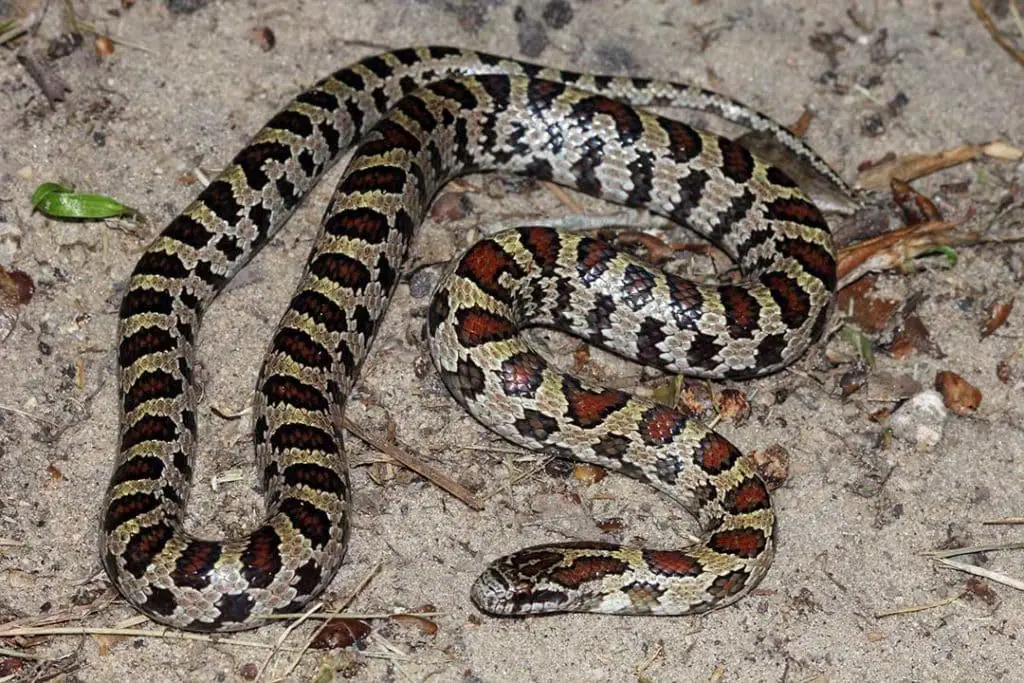
South Florida mole kingsnakes are 30-42 inches long and are gray, brown, or tan. They have at least 75 black-bordered brown blotches along the body. Older snakes may be entirely brown.
This kingsnake is endemic to Florida and is only found from Brevard County to Lake Okeechobee.
The western border is Charlotte and DeSoto counties. King snakes eat snakes, lizards, and small mammals. They are burrowers and rarely seen.
Northern Mole Kingsnake (Lampropeltis rhombomaculata)
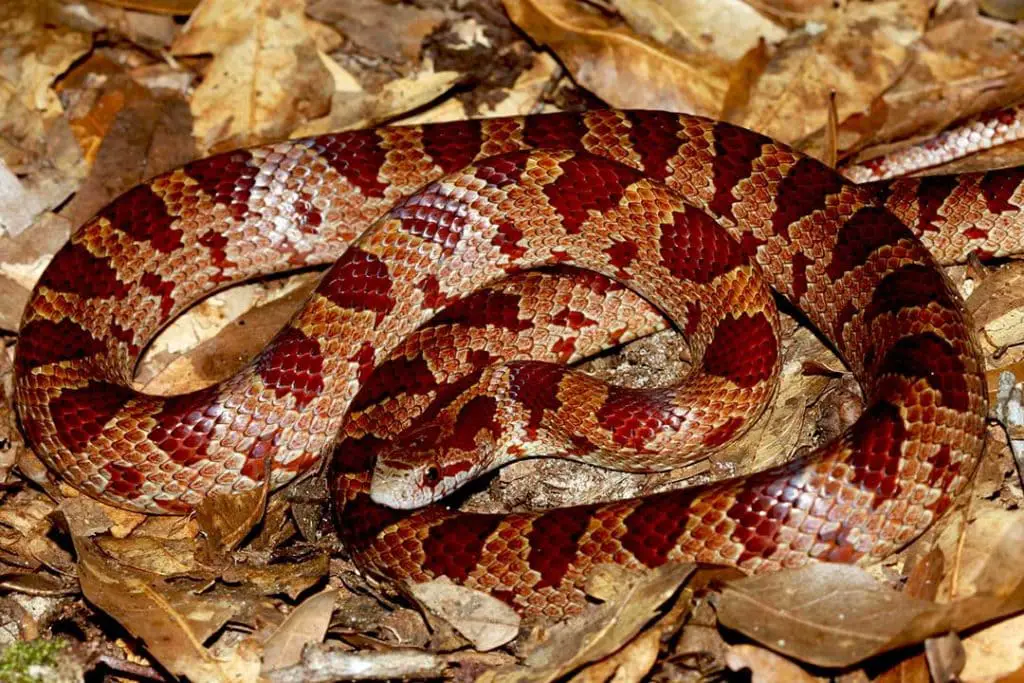
The northern mole kingsnake is typically 30-42 inches long as an adult.
They are gray, orange, or brown with reddish-brown blotches bordered with black. Juveniles are similar but tend to be more vivid and have a silvery background color.
They are found in the Panhandle with the eastern border of the range in Franklin and Liberty Counties.
Mole king snakes are powerful constrictors that prey on snakes, lizards, and small mammals. They are rarely seen since they spend most of their time underground.
Short-Tailed Snake (Lampropeltis extenuata)
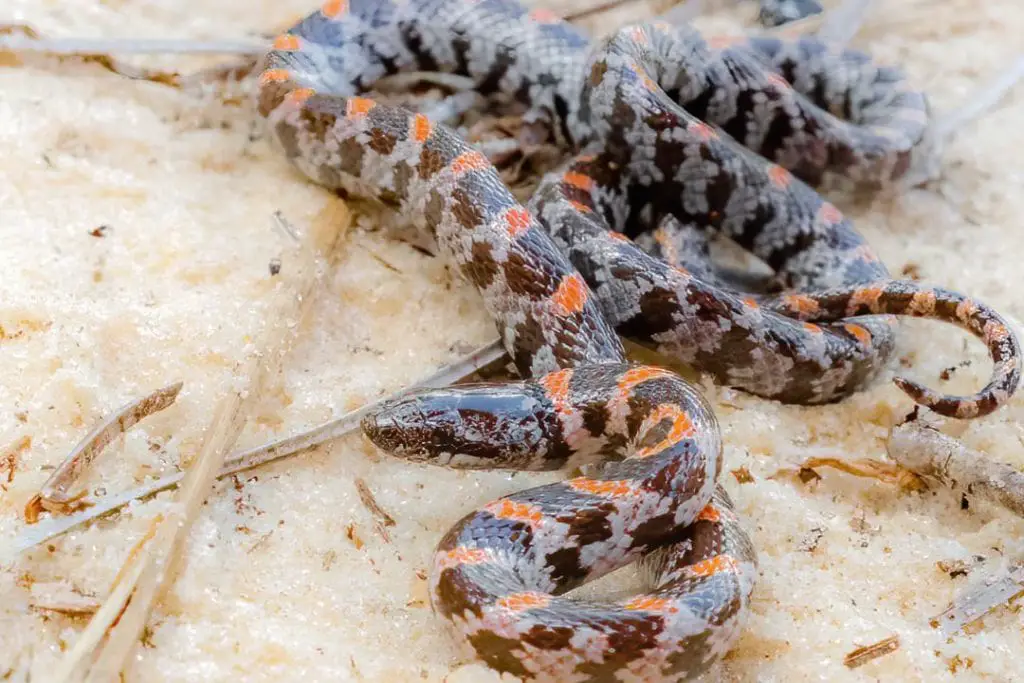
The short-tailed snake is 14-20 inches long with a short tail for the genus. They are gray with dark blotches or spots. They can have orange between the dark spots on the back.
They are only found in upland northern Central Florida and are endemic to the state.
They eat small snakes like Florida Crowned Snakes almost exclusively. Captive short-tailed snakes have taken small lizards, so they may eat these in the wild.
Scarlet Kingsnake (Lampropeltis elapsoides)
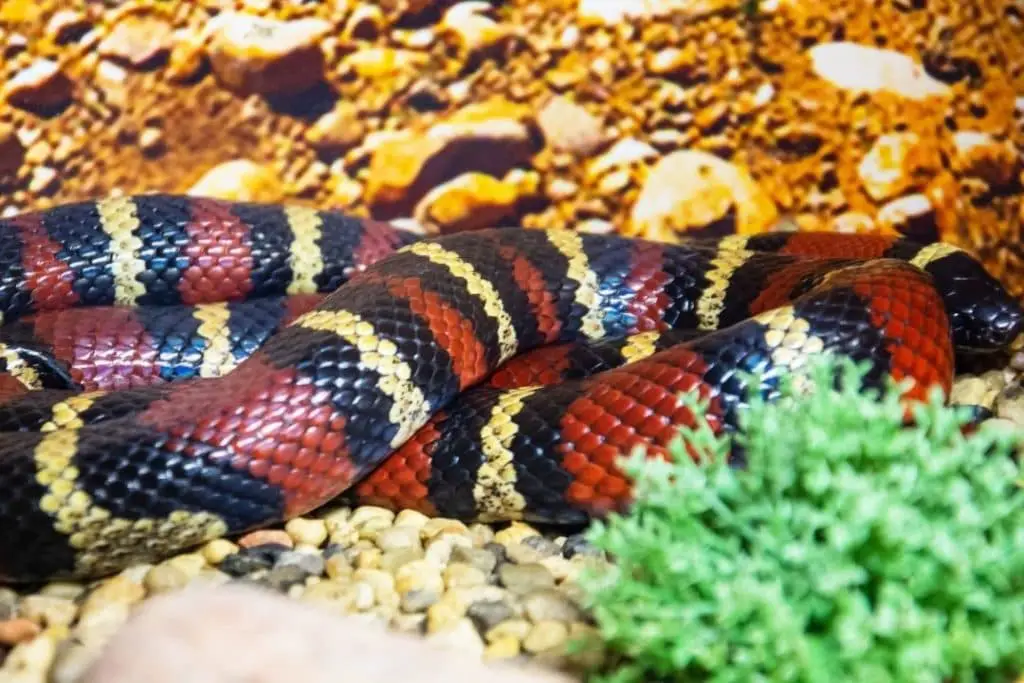
The scarlet kingsnake is a slender snake that is 14-20 inches long as an adult. They have shiny scales and red, yellow, and black rings that circle the body.
The yellow and red are separated by black rings. The snout is long with red on the nose. They are found in all of Florida, along with Key Largo and Key West.
They tend to eat small lizards and snakes, but large adults may eat mammals. They typically will strike and buzz the tip of their tail in leaf litter when threatened.
This can help differentiate them from coral snakes.
Common Kingsnake (Lampropeltis getula)
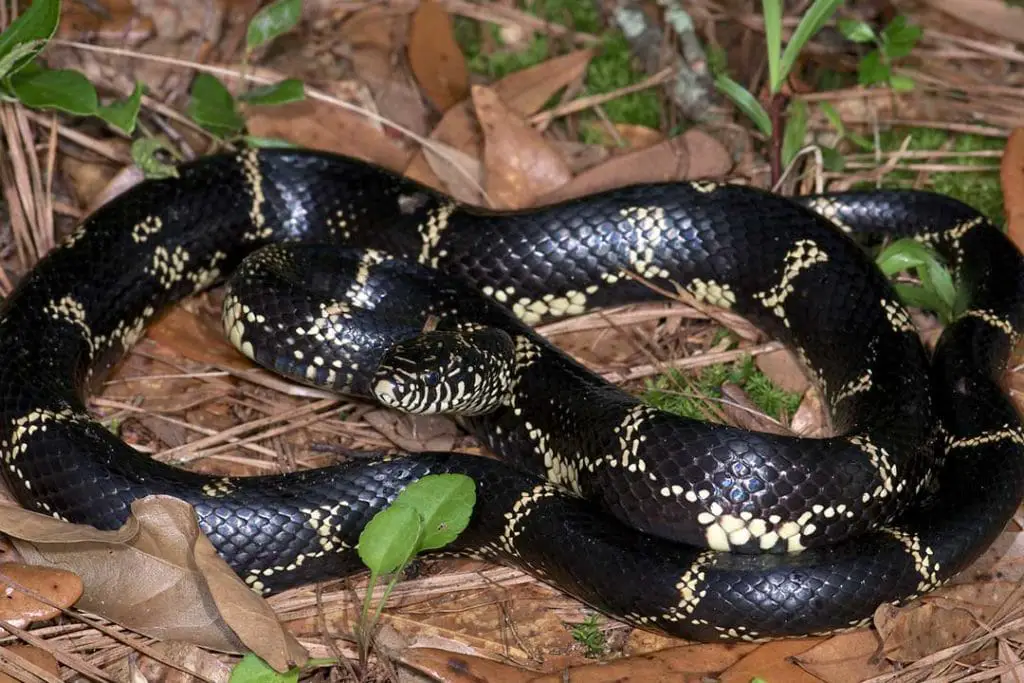
The common kingsnake is 36-48 inches long. This snake is highly variable, and some unusual-looking snakes used to be considered separate subspecies.
Most are black to brown with narrow, light crossbands. Some specimens may be light brown to yellow with yellow crossbands.
They may fade with age. They are found throughout all of Florida, but the lighter animals are more common in the southern part of the peninsula.
They eat a wide range of prey including other snakes. The lighter animals used to be called a separate subspecies, but this study considers that the former florida kingsnake – L. getula floridana is not a distinct subspecies.
Another former subspecies is the Apalachicola kingsnake, but they are just a lighter color morph found in the Panhandle.
Garter Snakes (Thamnophis)
Common Garter Snake (Thamnophis sirtalis)
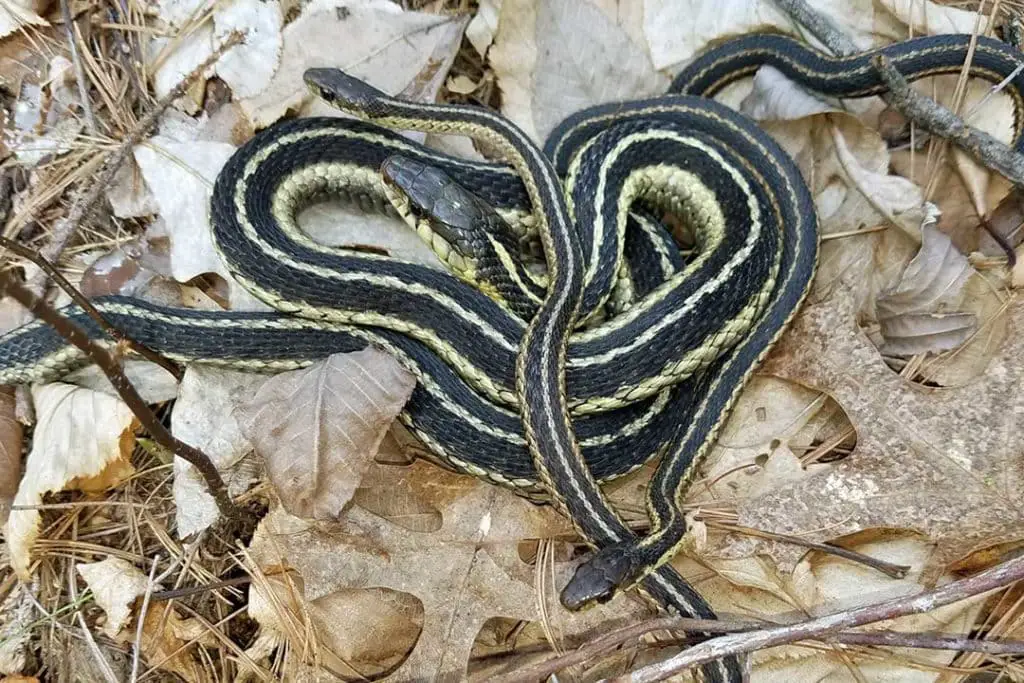
The common garter snake is a slender snake that averages 18-26 inches long. The garter snake has three stripes running down the body.
The stripes can be yellow, white, blue, green, or brown. The background color is black, gray, greenish-brown, or tan.
Some animals have a checkerboard pattern between the stripes.
Garter snakes can be found in all of Florida, but there is only one report from the Keys. They typically eat aquatic prey.
However, they will eat anything they can catch that is small enough to eat. Garter snakes are easy to confuse with ribbon snakes.
Ribbon snakes have a white patch in front of the eye and the side stripes are closer to the belly compared to garter snakes.
Eastern Ribbon Snake (Thamnophis saurita)
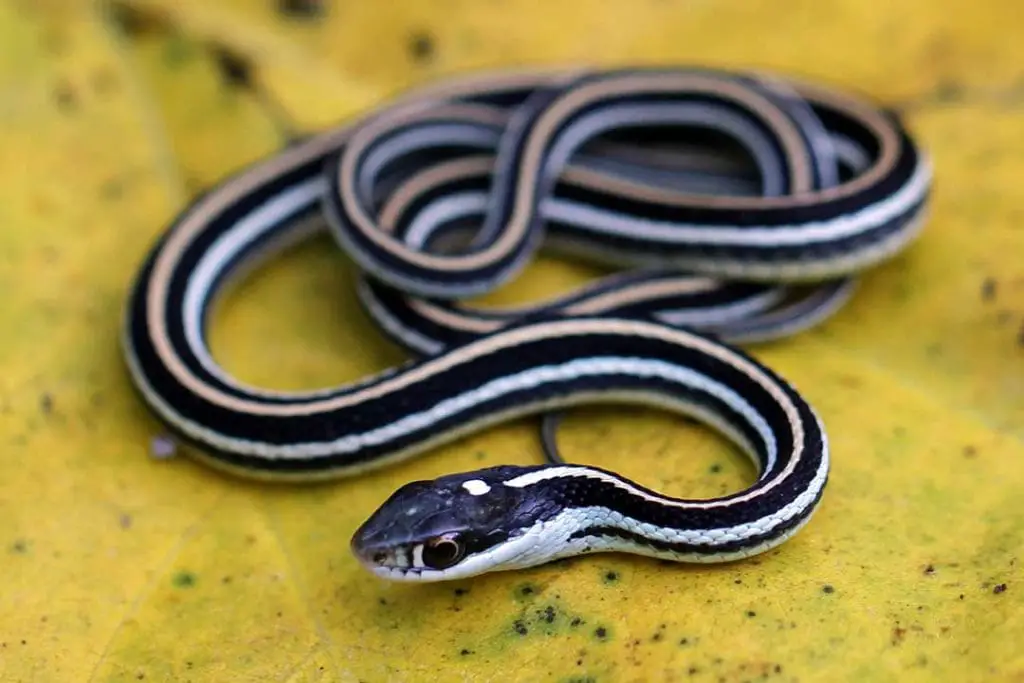
Eastern ribbon snakes are very slender snakes that tend to be 18-26 inches long as adults. They have brown, olive-green, or bluish-black backgrounds with three light stripes running down the body.
The stripes can be yellow, brown, blue, or light green. Some individuals may lack stripes. The head is barely distinct from the neck and has large eyes with a white spot in front of the eye.
They are found in all of Florida and the Keys aside from the Middle Keys. They eat frogs, fish, and salamanders.
They chase down prey and quickly eat it alive.
Racers (Coluber)
Black Racer (Coluber constrictor)
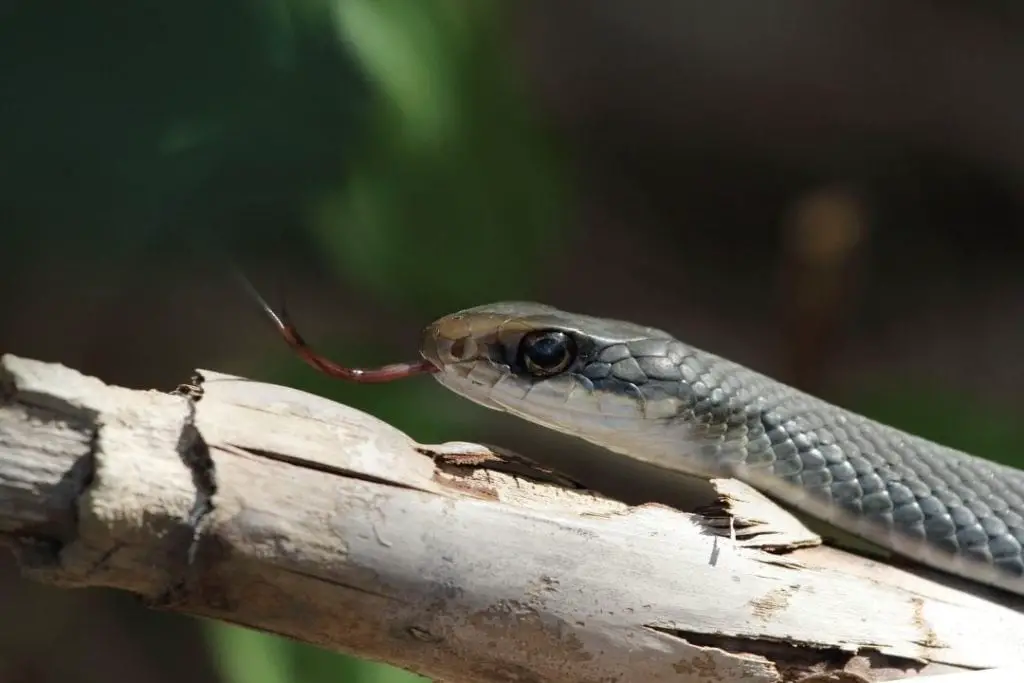
The black racer is 20-56 inches long on average as an adult.
They are long, slender, and have a blue or black color to the body with a white chin. Babies are gray with reddish-brown blotches.
They are found throughout all of Florida including the Keys. These snakes lay eggs and are powerful, active predators.
They eat small mammals, frogs, lizards, and birds. They chase down their prey and catch it in their jaws and force it to the ground.
Once the prey stops struggling, they consume it. Racers can move at a maximum speed of 10 miles per hour, which is about the same as a quick jog.
Water Snakes (Nerodia)
Brown Water Snake (Nerodia taxispilota)
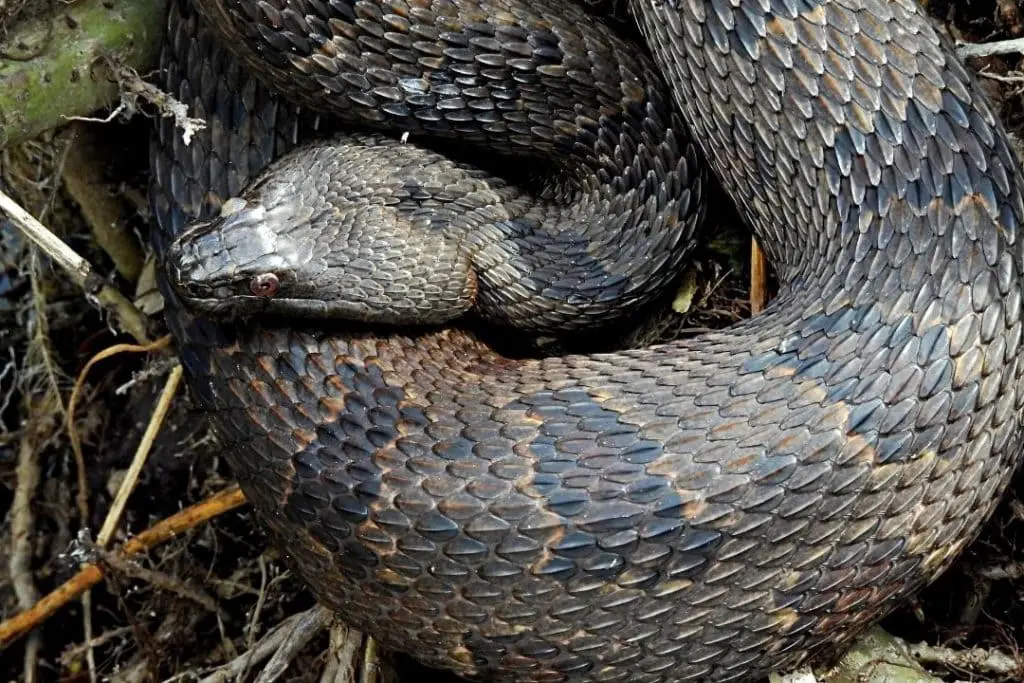
Brown water snakes are stout snakes that can be 30-60 inches long. They are brown with darker brown, square blotches that alternate on the back and sides.
They have large heads that are slightly distinct from the neck. They can be found over most of mainland Florida but cannot be found in the Keys.
The species eat freshwater fish with a heavy preference for catfish. They are active during the day for most of the year but will shift to nocturnal hunting on hot days.
Northern or Midland Water Snake (Nerodia sipedon pleuralis)
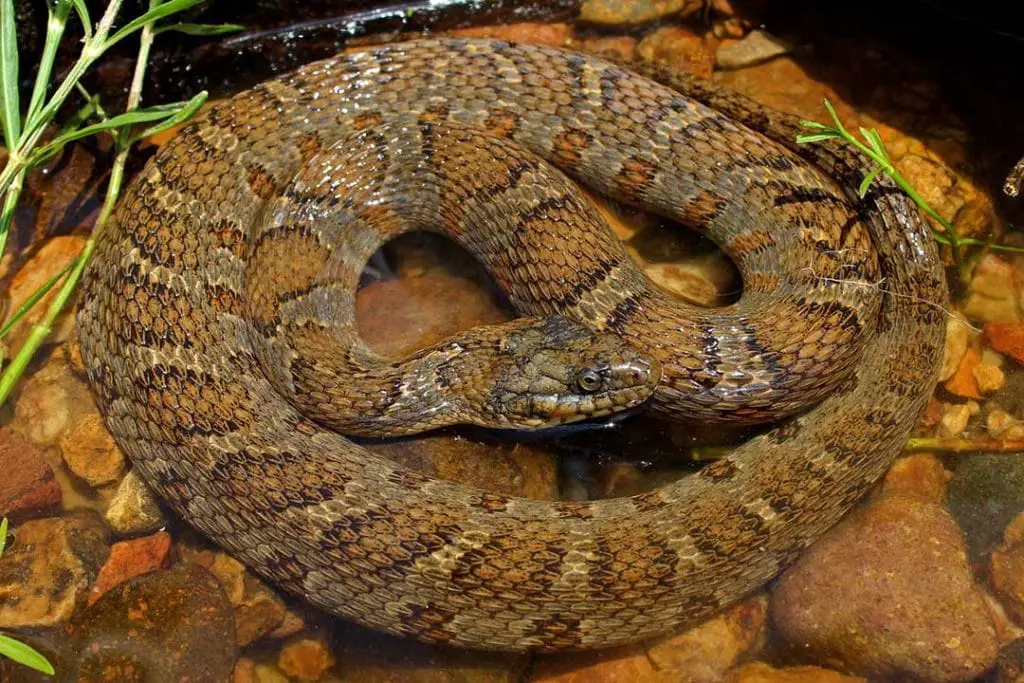
The midland water snake is 24-30 inches long. They are light brown with dark brown or reddish-brown crossbands near the neck that change into blotches further down the body.
Squarish blotches extend from the belly and alternate with the blotches on the back.
They are only found in a small section of the western Panhandle in the Yellow River, Escambia, and Choctawhatchee River basins.
They eat fish and amphibians. This is the only subspecies of the northern water snake found in Florida.
Southern or Banded Water Snake (Nerodia fasciata)
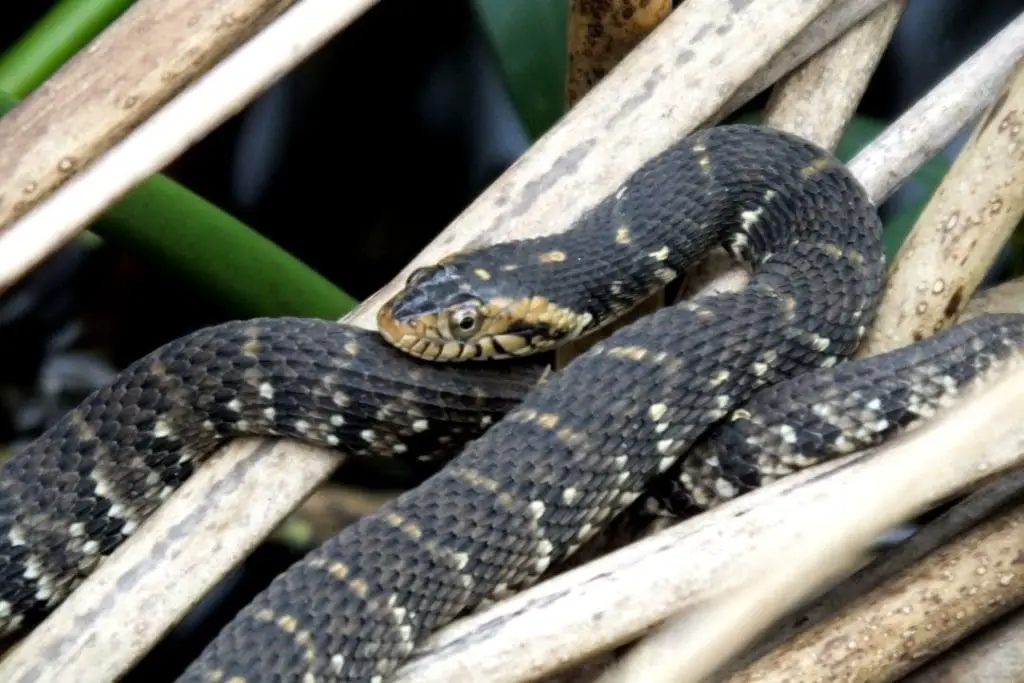
The Southern water snake is also called the banded water snake. The average adult is 22-42 inches and has a stout body.
They have large dark bands that may have black borders. The smaller bands between the larger ones will be tan, gray, or reddish-brown.
They may have a black stripe going down the back. Older snakes darken with age. The eyes are smaller with a round pupil and placed higher on the head.
They also have a dark marking going from the eye to the corner of the mouth. They can be found in mainland Florida, but are absent from the Keys.
These snakes eat mostly frogs and fish. Like all water snakes, they give birth to live babies.
Mangrove Saltmarsh Watersnake (Nerodia clarkii compressicauda)
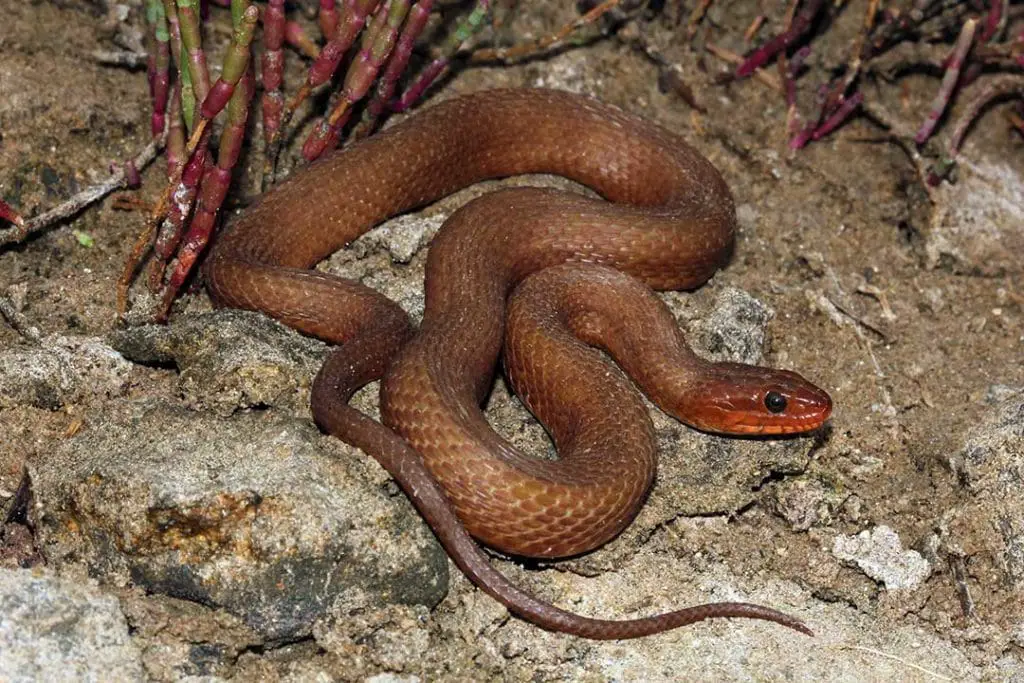
Mangrove Saltmarsh snakes are 15-30 inches long. These common non venomous snakes are highly variable and may be gray, brown, tan, olive, or orange with bands or stripes. Some animals have no patterns or may be black.
They only live in brackish water habitats around the coast and the Keys. They are currently threatened by habitat loss.
They eat mainly small fish, but will also eat fiddler crabs and small frogs. They are known for being docile and are the only snake in North America that lives only in brackish water.
Florida Green Water Snake (Nerodia floridana)
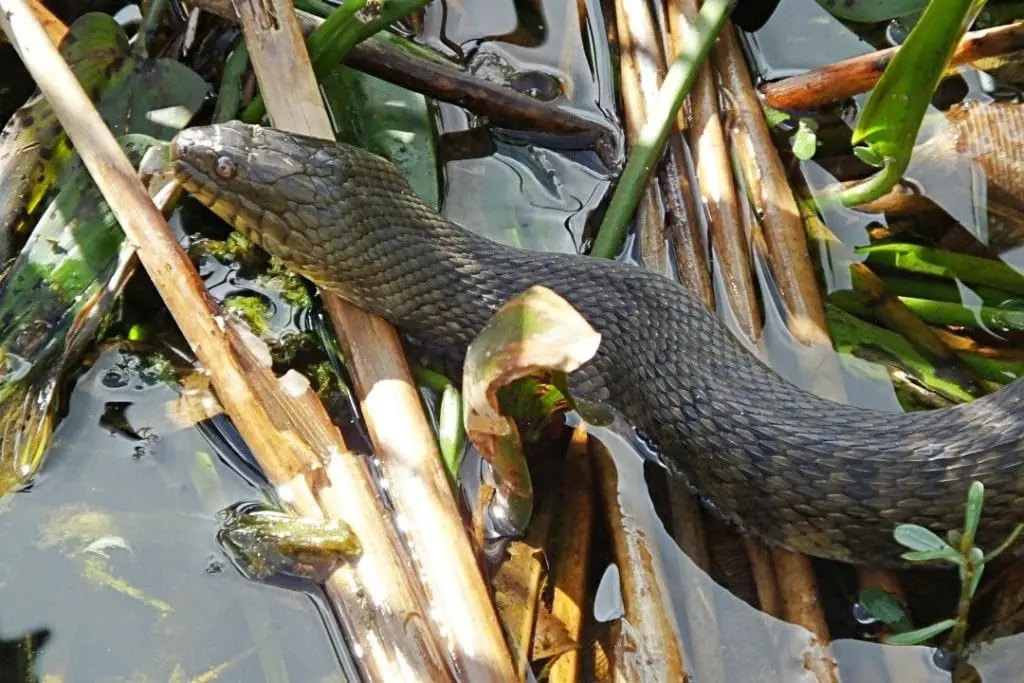
Florida green water snakes are stout snakes that tend to be 30-55 inches long.
They can be orange, green, or brown with only speckling for markings. They are found near freshwater in the peninsula and a small part of the Panhandle.
They eat amphibians and fish. They tend to flee under cover or into the water if threatened.
Mississippi Green Water Snake (Nerodia cyclopion)
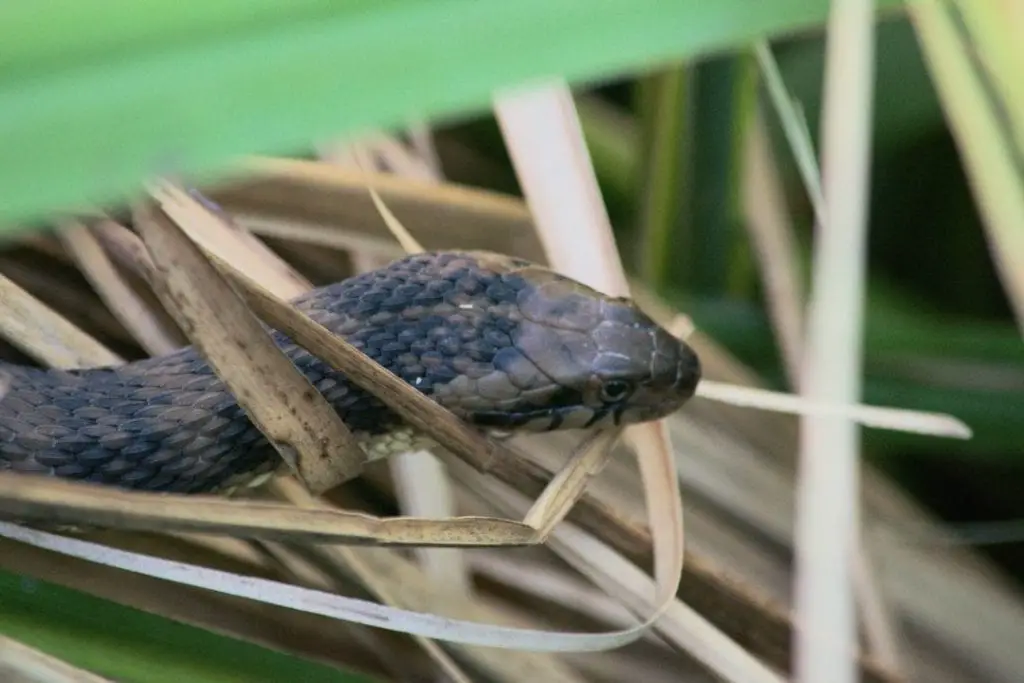
The Mississippi green water snake is 30-55 inches long have are a dark green color. They are stout and have a pattern of alternating darker markings on the back and sides.
They have a large head and scales between the eye and lip scales. The dark markings are more vivid on juveniles.
They have only been sighted in Escambia county close to the coast.
They eat amphibians and fish. Since they are so rare in Florida, most green watersnakes will be the Florida green water snake.
Plain-Bellied Water Snake (Nerodia erythrogaster)
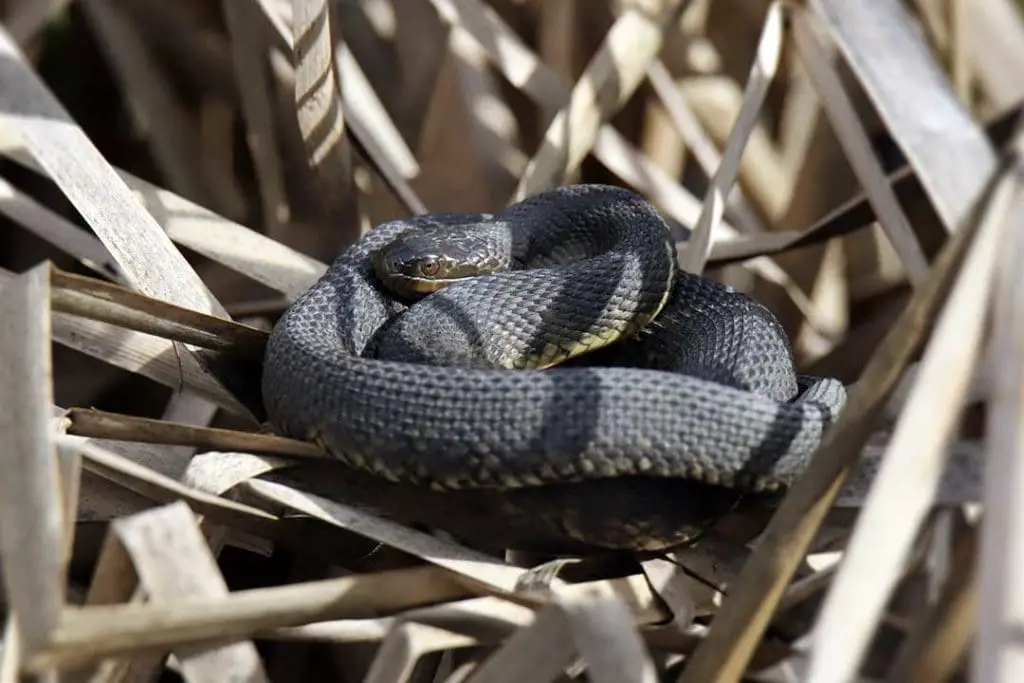
The plain-bellied water snake is 30-48 inches long. They are unpatterned and tend to be greenish-gray or reddish-brown with a yellow or orangish belly.
Juveniles are grayish-brown with dark crossbands and blotches for the first year of life. They can be found in the Panhandle west of the Ochlockonee River, but a separate population may be near the Santa Fe and Suwannee Rivers.
They eat frogs and fish and consume their prey alive.
The plain-bellied water snake has no subspecies and is instead a very widespread species that can be found over a huge portion of North America.
Crayfish Snakes (Liodytes)
Striped Crayfish Snake (Liodytes alleni)
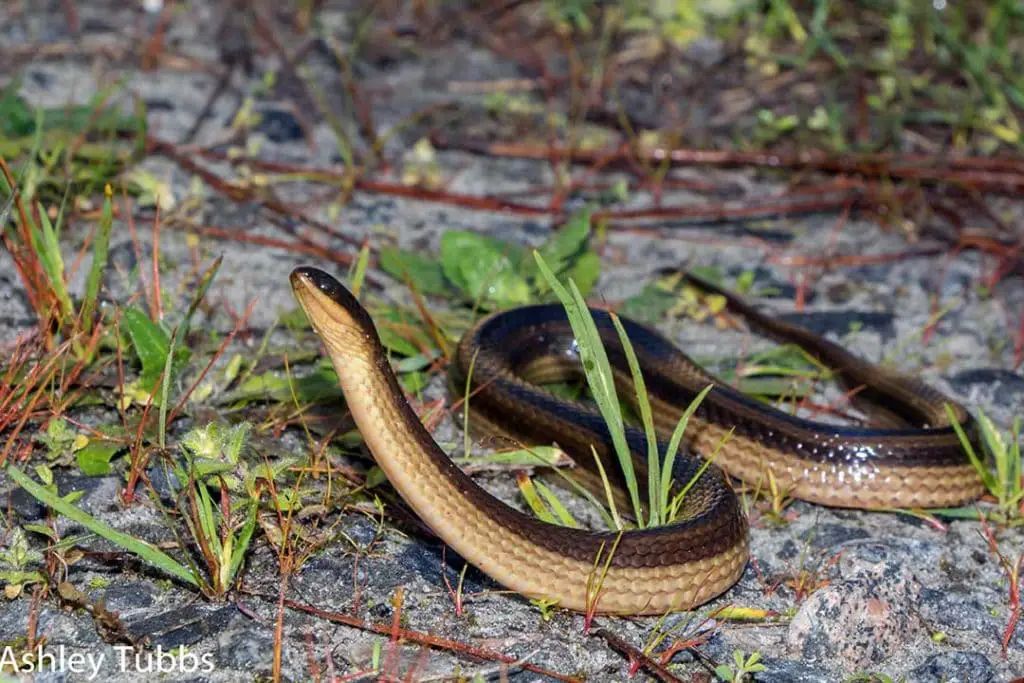
The striped crayfish snake is 13-20 inches long. They are a glossy brown with darker, broad stripes. They have small heads and large eyes.
They live throughout the peninsula and the eastern portion of the Panhandle. They eat mainly hard-shelled crayfish, but juveniles eat dragonfly nymphs and shrimp.
These snakes are aquatic and heavily prefer slow-moving water with plenty of vegetation and populations of crayfish.
They favor water hyacinth patches and can be very abundant in these patches.
Black Swamp Snake (Liodytes pygaea)
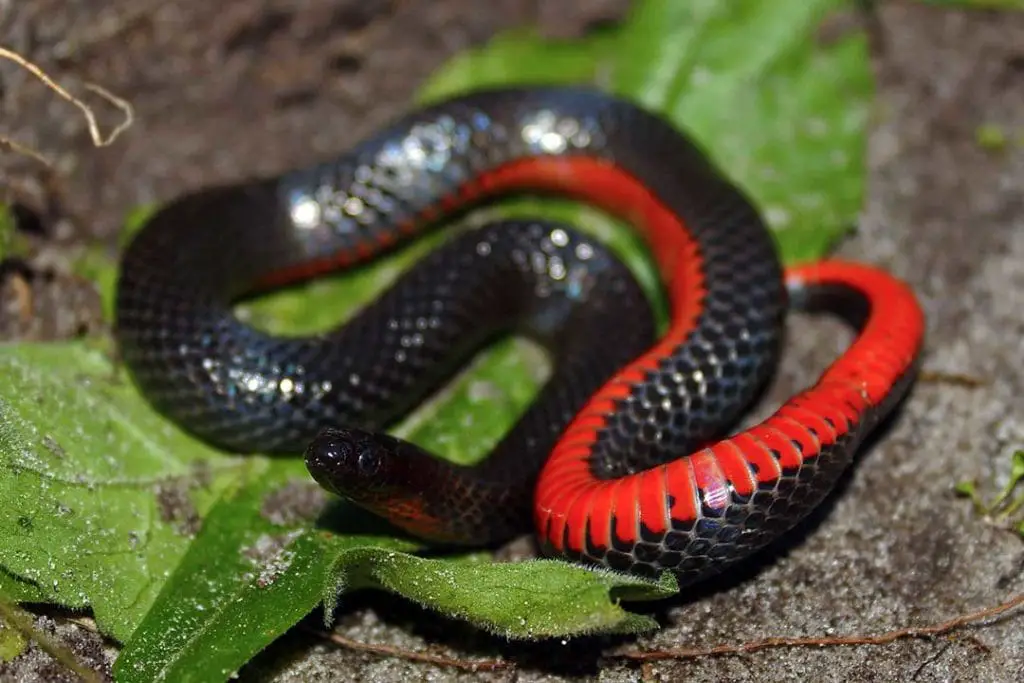
Black swamp snakes are 10-15 inches long. They are shiny black with red bellies.
They live throughout the peninsula and the Panhandle east of Santa Rosa County. They eat leeches, earthworms, frogs, fish, salamander, and arthropods.
They live only in slow-moving or still water that is filled with heavy vegetation.
Glossy Crayfish Snake (Liodytes rigida)
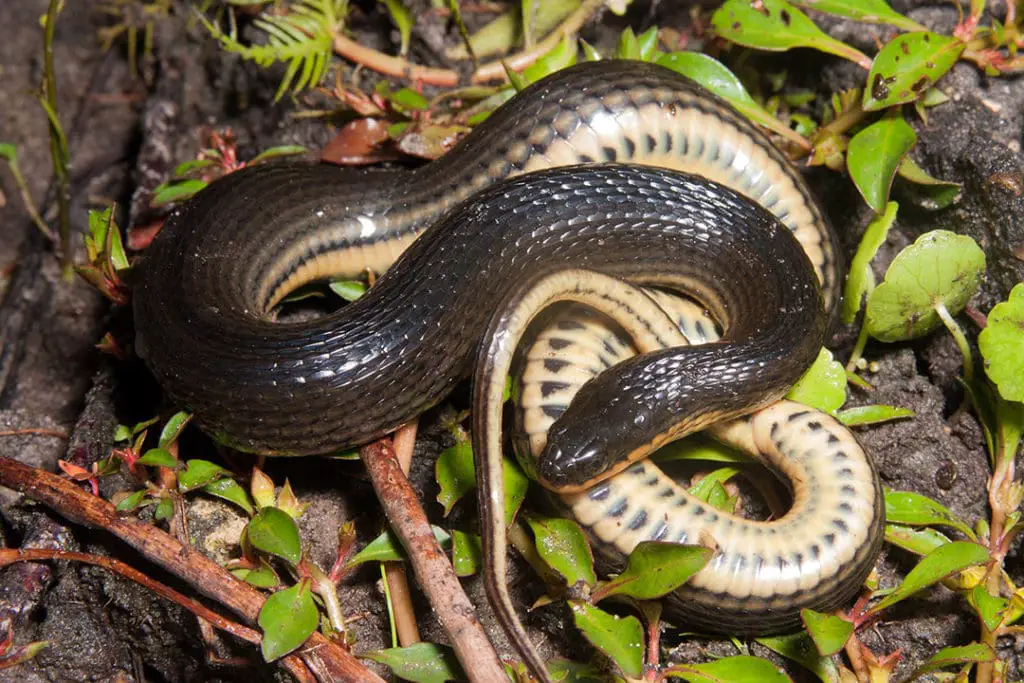
The glossy crayfish snake is 14-24 inches long. They are a glossy brown and may have faint stripes.
They have large eyes and yellow lip scales. They live in the Panhandle and the peninsula north of Osceola County.
They eat crayfish mainly, but will also eat other aquatic prey. There are two separate subspecies in Florida, the Gulf swampsnake (L. r. sinicola) and the Eastern glossy crayfish snake (L. r. rigida).
Queensnakes (Regina)
Queensnake (Regina septemvittata)

Queensnakes are 15-24 inches with strong ridged scales.
They are olive-green to brown with yellowish stripes low on the sides. They have white lip scales and the scales are dull. They are only found in the Panhandle and are highly aquatic.
They prefer cool, clear, fast-moving streams with rocky bottoms. They eat freshly molted crayfish, but will occasionally eat other aquatic prey.
Coachwhips (Masticophis)
Coachwhip (Masticophis flagellum)
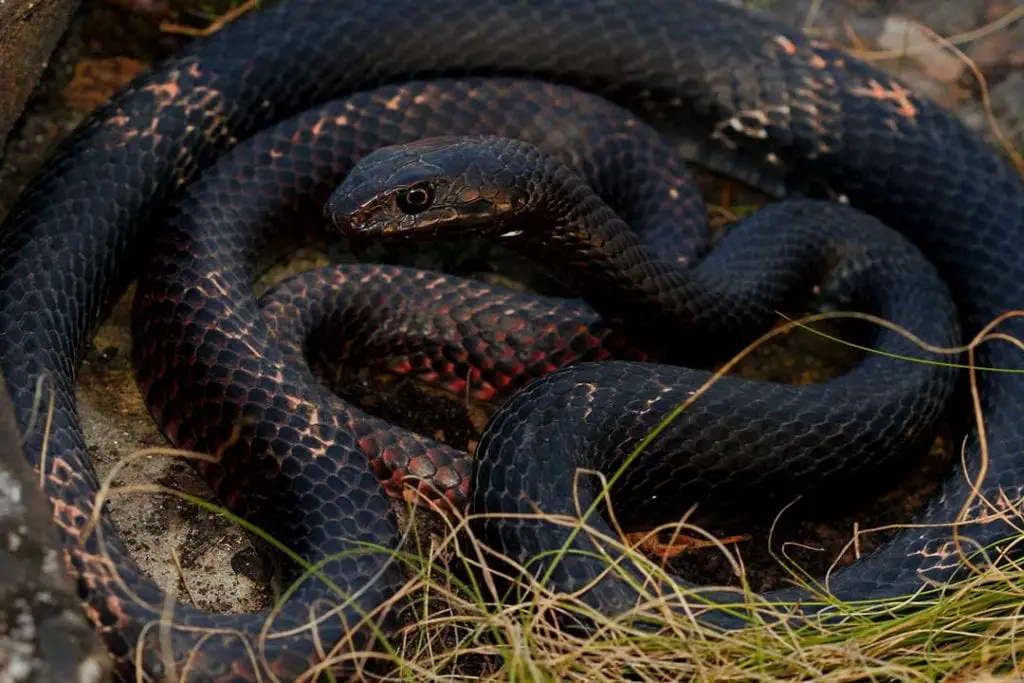
Coachwhips are typically 42-60 inches long as adults and are slender. They have a black head and neck that fades to a light tan at the tail. They have large eyes with yellow irises.
Juveniles are tan with dark crossbands. They can be found throughout most of Florida aside from the Keys and the wetlands south of Lake Okeechobee.
They prefer dry and open habitats. These snakes eat nearly anything they can catch and overpower. Their common name comes from their resemblance to a braided whip.
Crowned Snakes (Tantilla)
Florida Crowned Snake (Tantilla relicta)
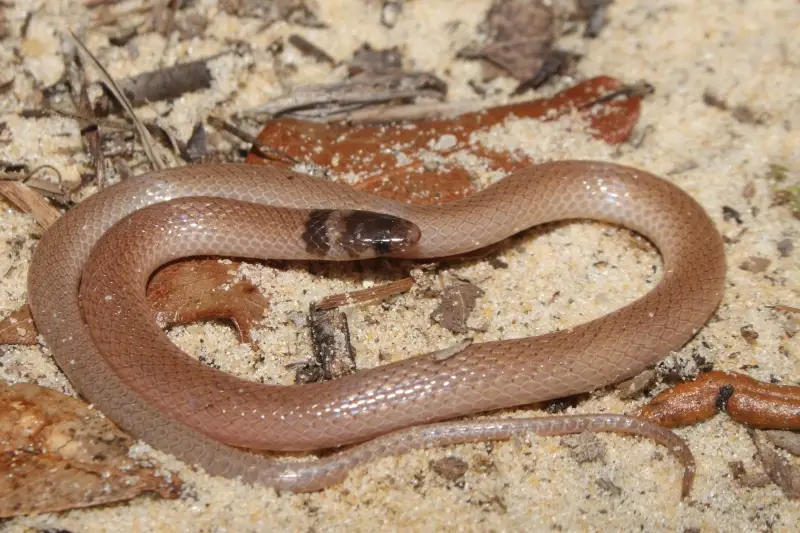
The Florida crowned snake is thin and only 7-10 inches long. They are tan to brown with a dark head.
They have three subspecies with populations scattered around peninsular Florida. None are found in the Panhandle, Keys, or the furthest parts of Southern Florida.
They have a mild venom that is used to hunt beetle larvae and some other invertebrates. They are harmless to humans and do not typically bite even in defense.
Southeastern Crowned Snake (Tantilla coronata)
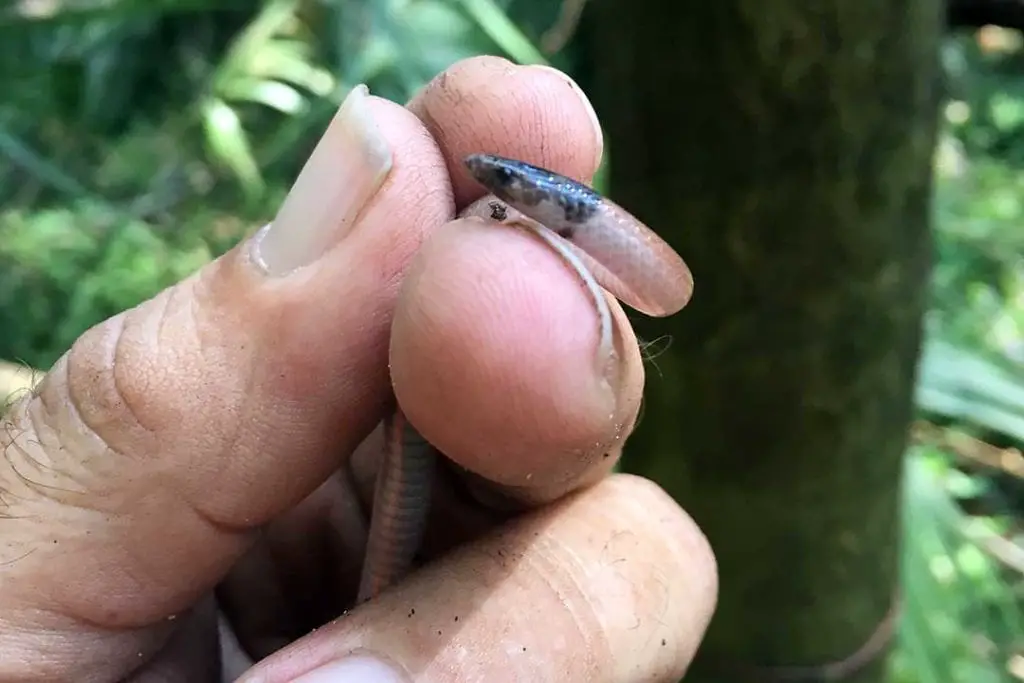
Southeastern crowned snakes are only 8-10 inches long.
They have a tan to reddish body with a dark head. They have a light band on the back of the head and a black band right behind it. Hatchlings are grayish with darker heads.
They are found in the Panhandle west of Leon County. They eat invertebrates and hunt using mild venom. They do not typically bite humans, preferring to squirm and musk to escape.
Rim Rock Crowned Snake (Tantilla oolitica)
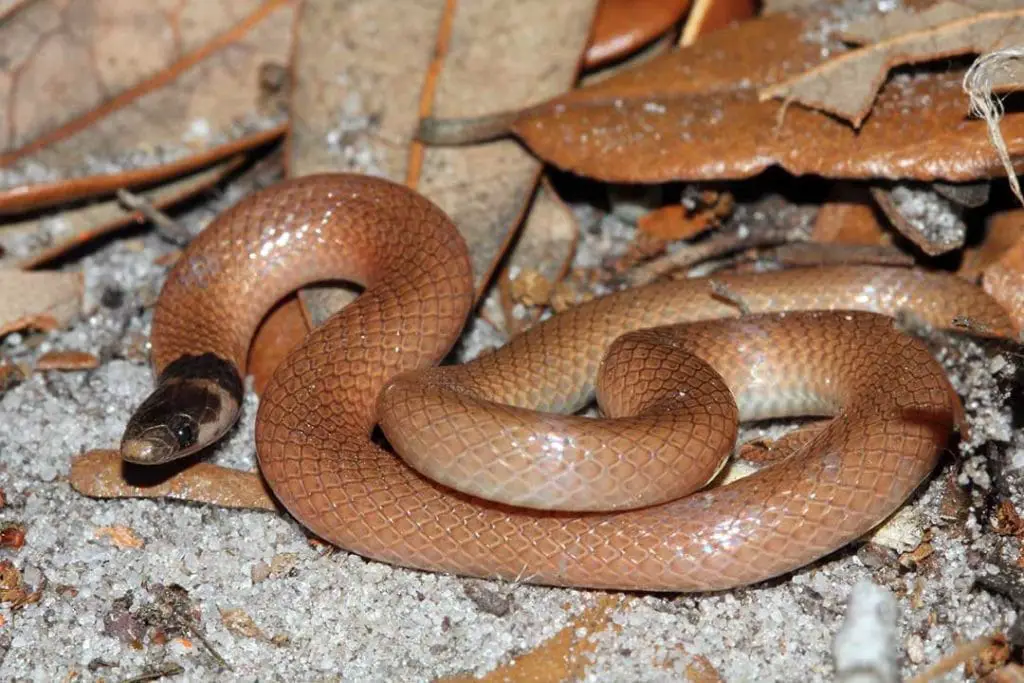
The rim-rocked snake is thin and 7-9 inches long.
They are tan to light brown with a dark head. The eyes are small and the tip of the snout is tan.
They are endemic to Florida and can only be found in Miami-Dade and Monroe Counties.
They eat invertebrates. On the mainland, they can only be found in the Miami Rim Rock Formation.
Red-Bellied Snakes (Storeria)
Florida Brownsnake (Storeria victa)
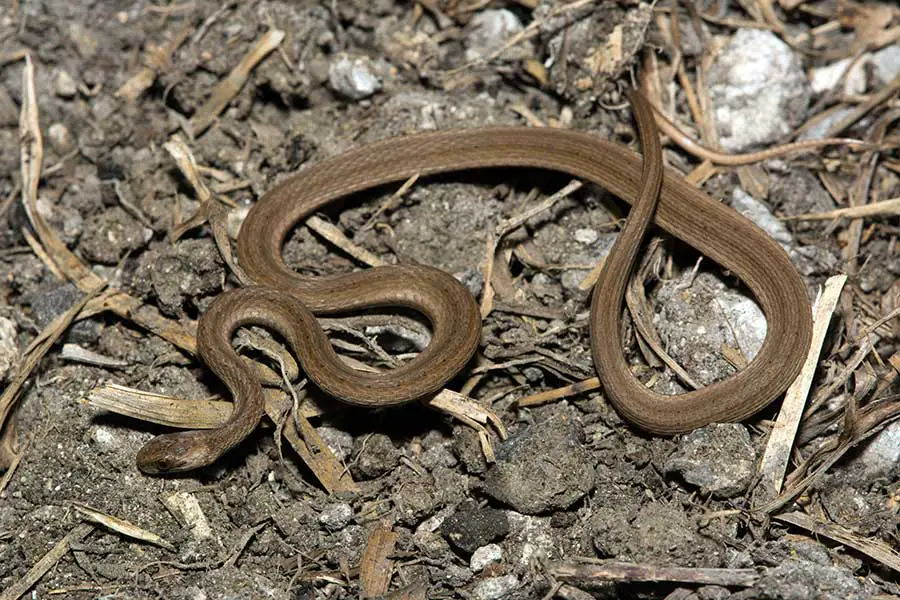
The Florida brown snake are a slender snake that is 9-13 inches long. They are a rusty or tannish brown. They have a faint stripe bordered by rows of black spots which can connect over the back.
The upper lips are whitish aside from dark spots under the eyes. Juveniles are dark brown with a whitish band behind the head.
They are found in the peninsula south of Duval County on the east coast going diagonally to the Suwannee River on the Gulf Coast side.
They can also be found in the upper Florida Keys. Little is known about the diet aside from it being similar to the Dekay’s brown snake. This means they likely eat slugs, earthworms, and insects.
Dekay’s Brownsnake (Storeria dekayi)
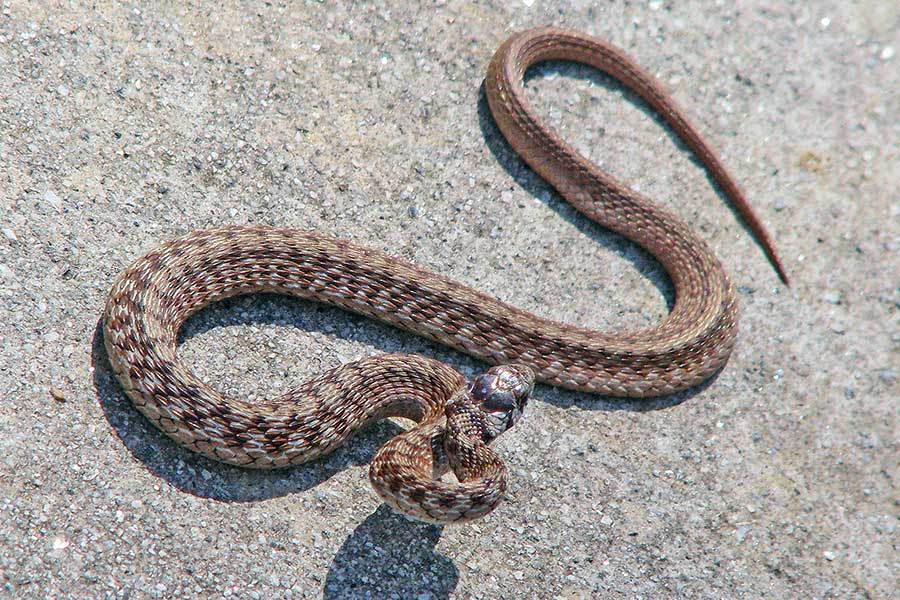
The Dekay’s brownsnake is a slender snake that is only 9-13 inches long. They are grayish-brown to light brown with a darker head with a light band across the back.
They may have a faint stripe on the back that is bordered by rows of black spots. Juveniles are darker with a white band on the back of the head.
They can be found in the Florida Panhandle west of the Aucilla River. These secretive snakes are found under leaf litter or debris.
The majority of the diet is made up of earthworms and slugs. They will also eat a wide range of other small prey so long as they can overpower it and consume it alive.
Dekay’s brown snakes are frequently found while doing yardwork since they eat common garden pests.
Red-Bellied Snake (Storeria occipitomaculata)
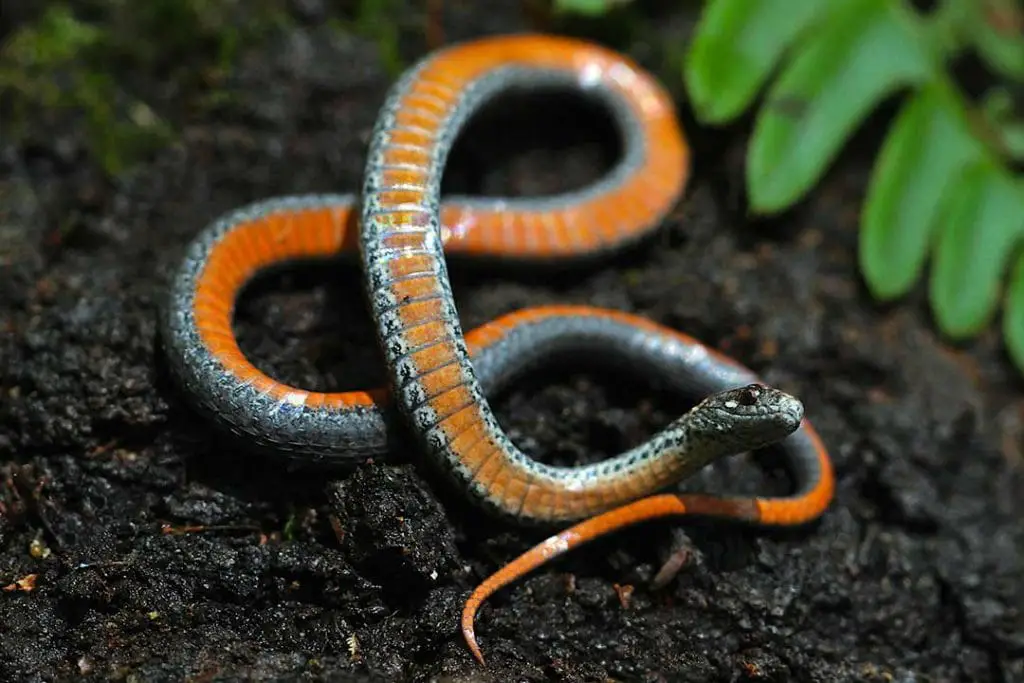
The red-bellied snake is a thin snake that is 8-10 inches long as an adult. They are gray to a reddish-brown with 1-5 stripes down the back.
The head is dark with a light collar around the neck. The belly is bright red. Juveniles are darker with a white band across the back of the head.
The can be found in the Panhandle and the peninsula north of Pasco and Orange Counties. They eat slugs and earthworms.
When handled, they will squirm, musk, and flatten the body. Very agitated red-bellied snakes may pull back the upper lip to expose the teeth.
Hognose Snakes (Heterodon)
Eastern Hognose Snake (Heterodon platirhinos)
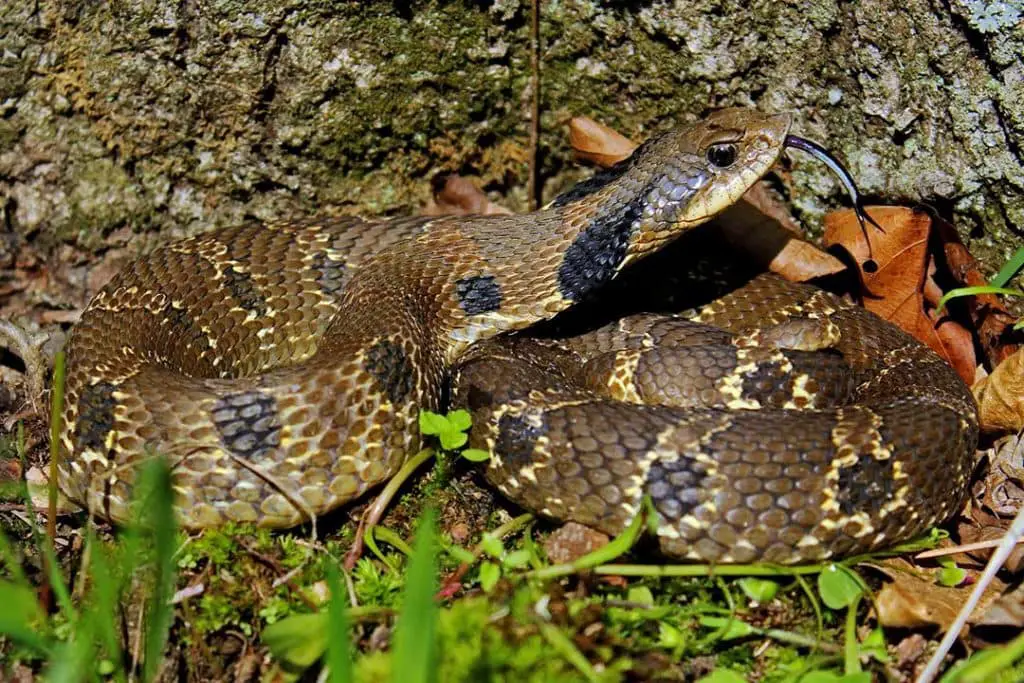
Eastern hognose snakes are 20-33 inches long.
They are thick-bodied and have a distinctive upturned snout. They are highly variable in color. They can be yellow, tan, olive, brown, gray, orange, or brown.
The pattern is typically dark blotches that are larger on the back than the sides. Juveniles are similar to adults but the colors tend to be more vivid.
They are found throughout mainland Florida. Eastern hognoses typically eat toads that they dig up using their upturned snouts but they will take other prey.
Eastern hognoses are known for their dramatic defense displays that include flattening the head and neck like a cobra, hissing, and playing dead if they cannot escape.
Southern Hognose Snake (Heterodon simus)
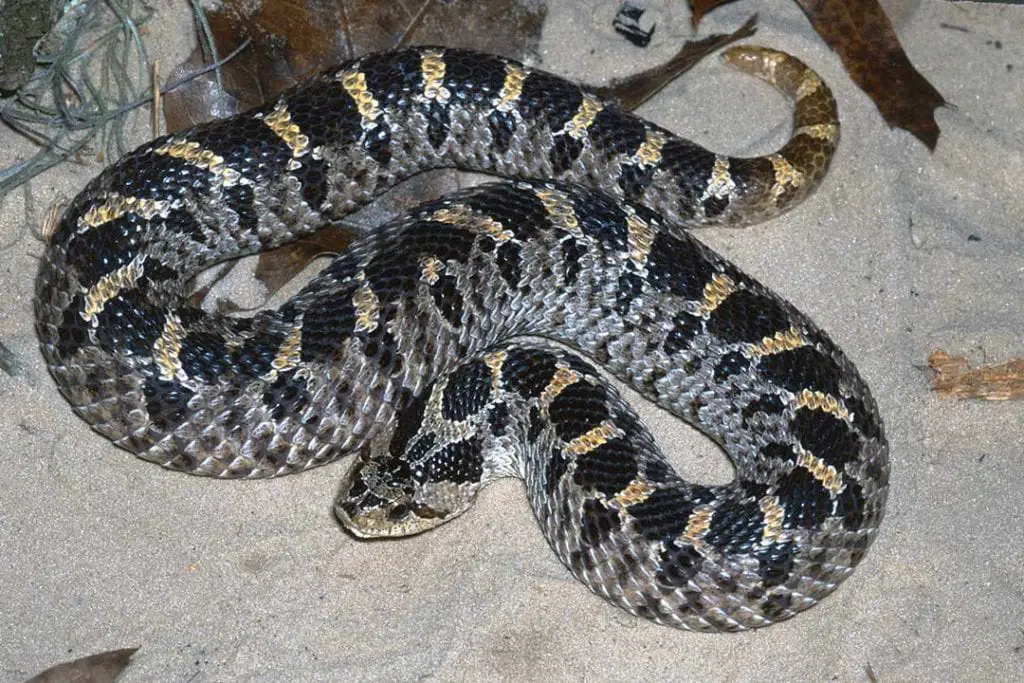
The southern hognose snake is 18-22 inches long and has an upturned snout. They are typically a light gray, tan, brown, or red with dark blotches on the back and sides.
They can have reddish-orange between the dorsal blotches. They have a dark band that goes from the jaw through the eyes. They can be found in the Panhandle and the northern and central peninsula above St. Johns River.
They eat mainly frogs and toads, but will also eat lizards and mammals. They can be told apart from Eastern hognoses by the more upturned snout on the southern hognose and from pygmy rattlesnakes by the snout and lack of a rattle.
Green Snakes (Opheodrys)
Rough Green Snake (Opheodrys aestivus)
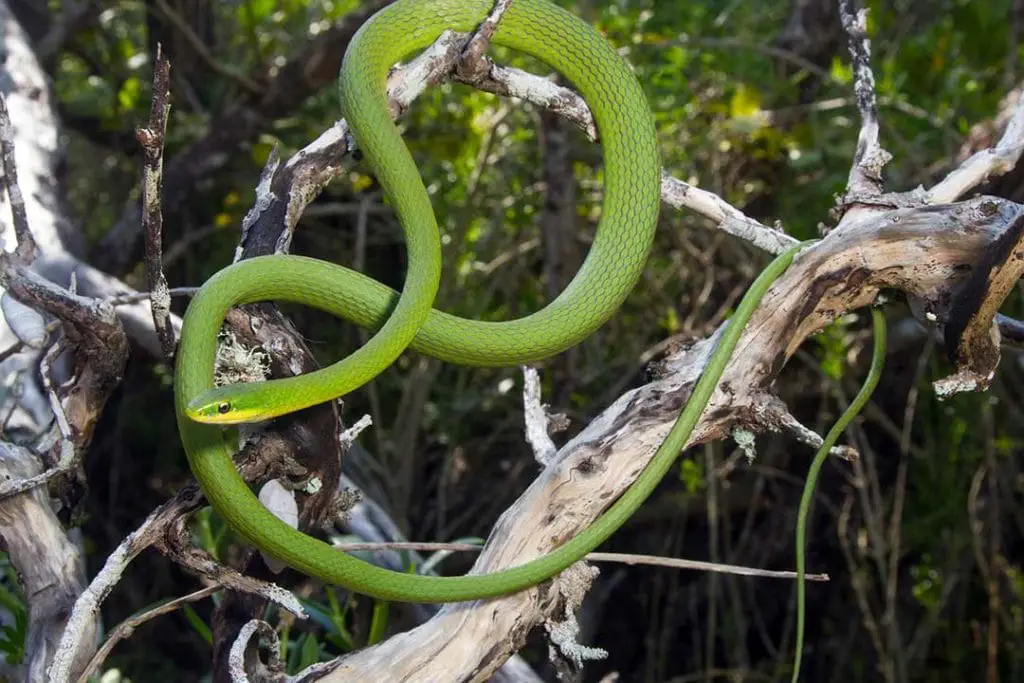
The rough green snake is a slender, arboreal snake that averages 14-33 inches long as an adult.
They are bright green with a yellow or cream belly. Juveniles are similar but can be duller in color. They are found throughout all of Florida and the Keys.
Rough green snakes eat insects and spiders. Prey is typically caught and then eaten headfirst without killing the prey.
Rainbow Snakes (Farancia)
Rainbow Snake (Farancia erytrogramma)
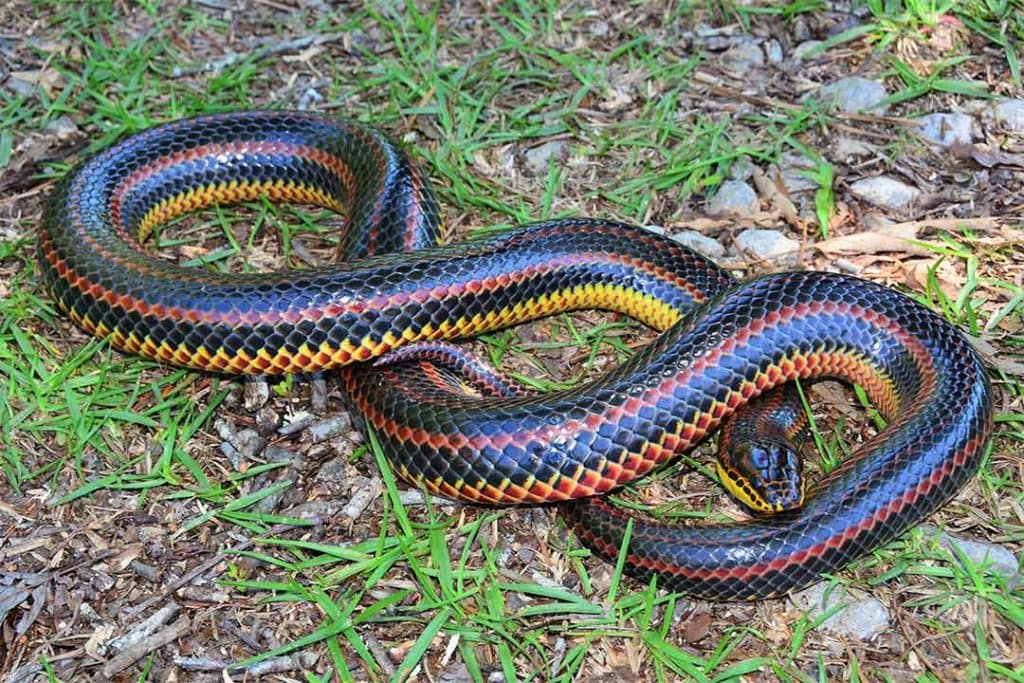
Rainbow snakes are large, thick snakes that tend to be 27-48 inches long.
They have glossy black backs that look blue in the light. They also have three thin red stripes down the body. The lower sides can be yellow or pink.
The belly has the same colors broken up in spots. Males have fewer spots on the belly than females. Juveniles look similar to adults but lack yellow.
They can be found in the Panhandle and some areas of the northern peninsula. Adults eat freshwater eels almost exclusively, while juveniles eat tadpoles and earthworms.
Red-Bellied Mudsnake (Farancia abacura)
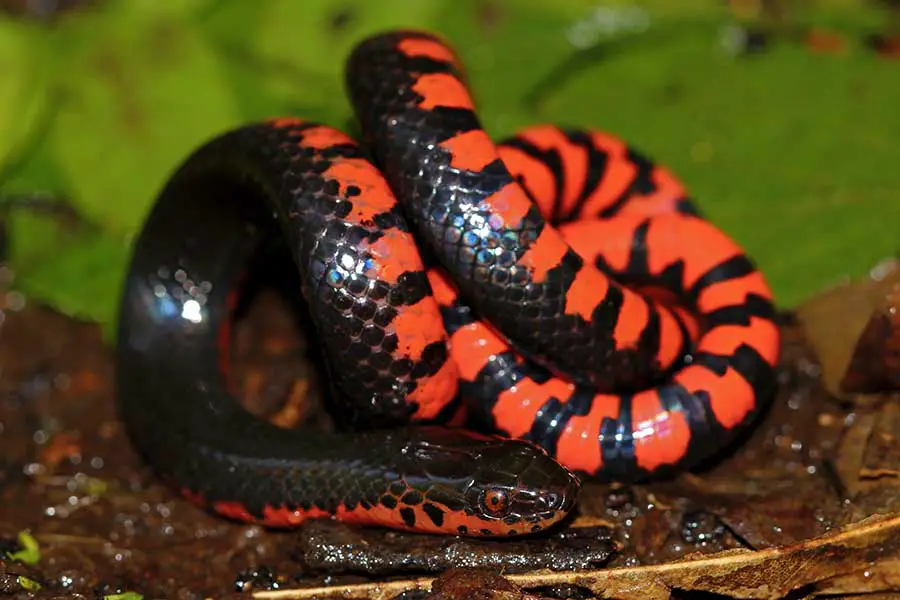
The red-bellied mudsnake is a thick-bodied snake that can be 40-54 inches long as adults. The back is a glossy black with pink to red bars extending up from the belly.
The belly is the same color with alternating black bars as well.
The chin and lips are yellow with a black spot on each scale. Juveniles look the same but the colored bars extend further up the sides.
They can be found throughout Florida aside from the Keys. Their diet mainly consists of aquatic salamanders, but they will also eat frogs, tadpoles, and occasionally fish. They musk and flail if handled.
Indigo Snakes (Drymarchon)
Eastern Indigo Snake (Drymarchon couperi)
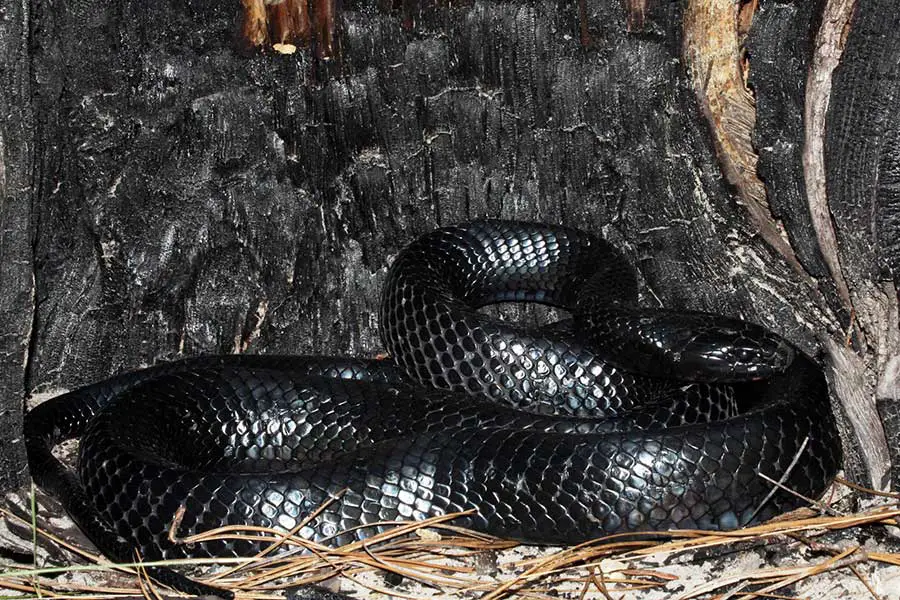
Eastern indigo snakes are large and can be 60-82 inches long.
This makes them one of the largest native snakes. They are glossy black with blue or purple highlights in the sun. The chin is red or orange. Juveniles are black with whitish bands.
They live throughout Florida but they are rare in the Keys. They will eat any vertebrate they can overpower. They chase down their prey and typically eat it alive or chew it until it is subdued.
Pine Snakes (Pituophis)
Pine Snake (Pituophis melanoleucus)
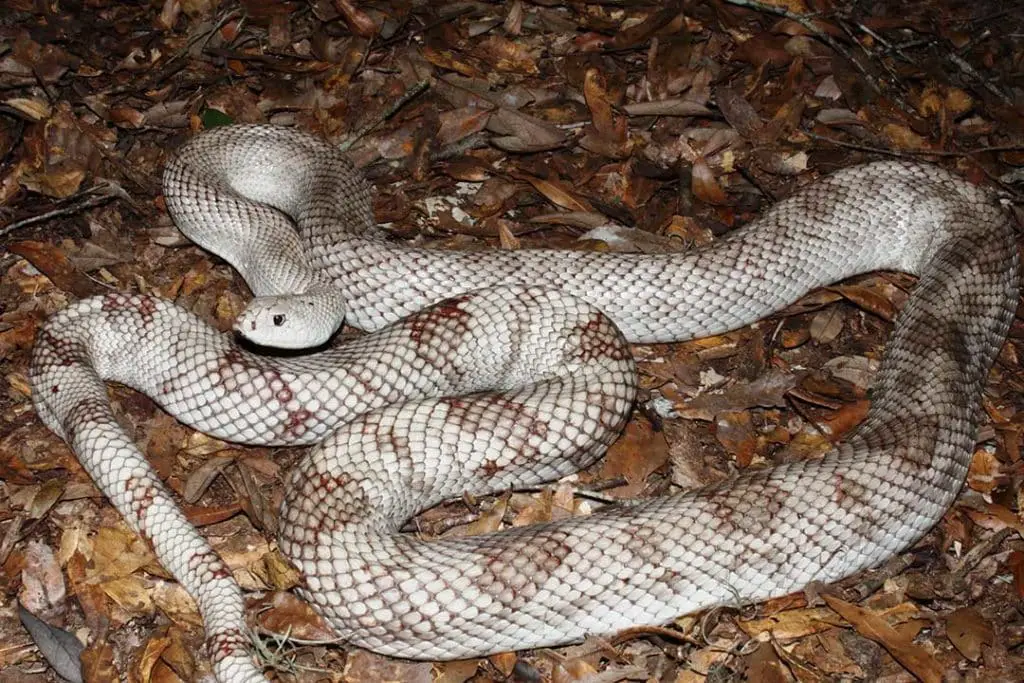
Pine snakes are thick snakes that are 48-66 inches long.
They have indistinct brown blotches on a lighter brown background. Juveniles are brighter and have a more distinct pattern. They are found in most of Florida aside from the Keys and part of the southern peninsula.
They eat mainly pocket gophers, but they will eat other vertebrate prey.
They hunt by chasing their prey into the burrow and crushing it against the walls. On the surface, they constrict their prey.
Rat Snakes (Pantherophis)
Red Corn snake (Pantherophis guttatus)
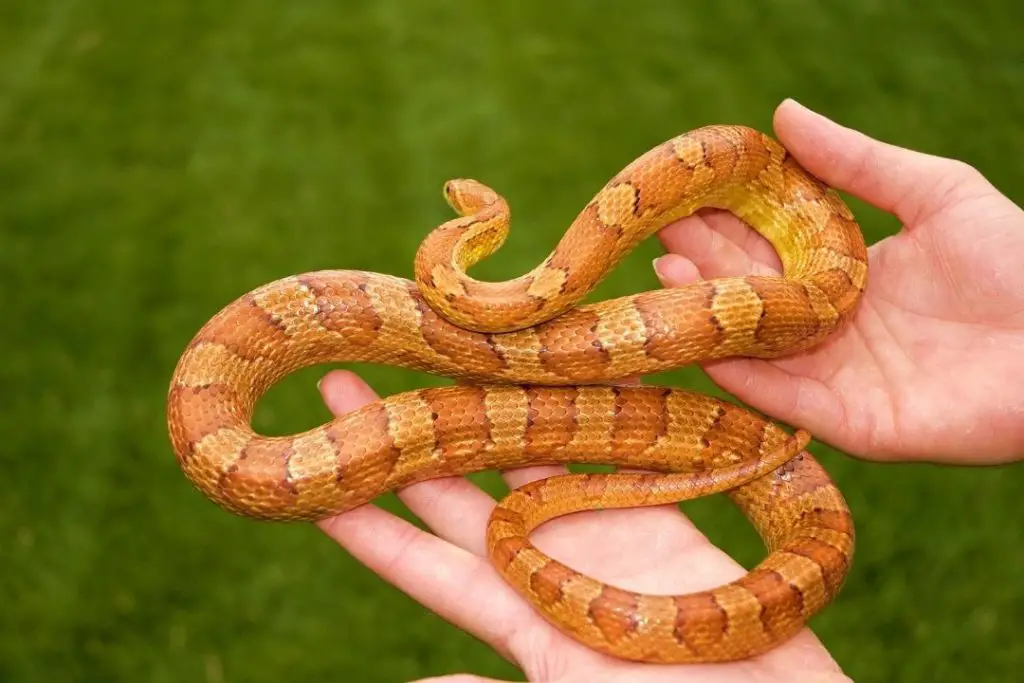
The red cornsnake is one of the most popular pet snake. They tend to be between 30-48 inches as adults but large individuals can reach close to 6 feet long.
The base color of adults is orangish-brown. They have red, brown, or orange blotches bordered in black along the body and a spear-shaped head marking.
Juveniles red corn snake look similar but can be browner in tone. They are found throughout Florida including the Keys. They eat primarily small mammals like rodents but will eat other vertebrate prey or eggs.
They are constrictors, but they will eat small prey alive occasionally.
Gray Ratsnake (Panterophis spiloides)
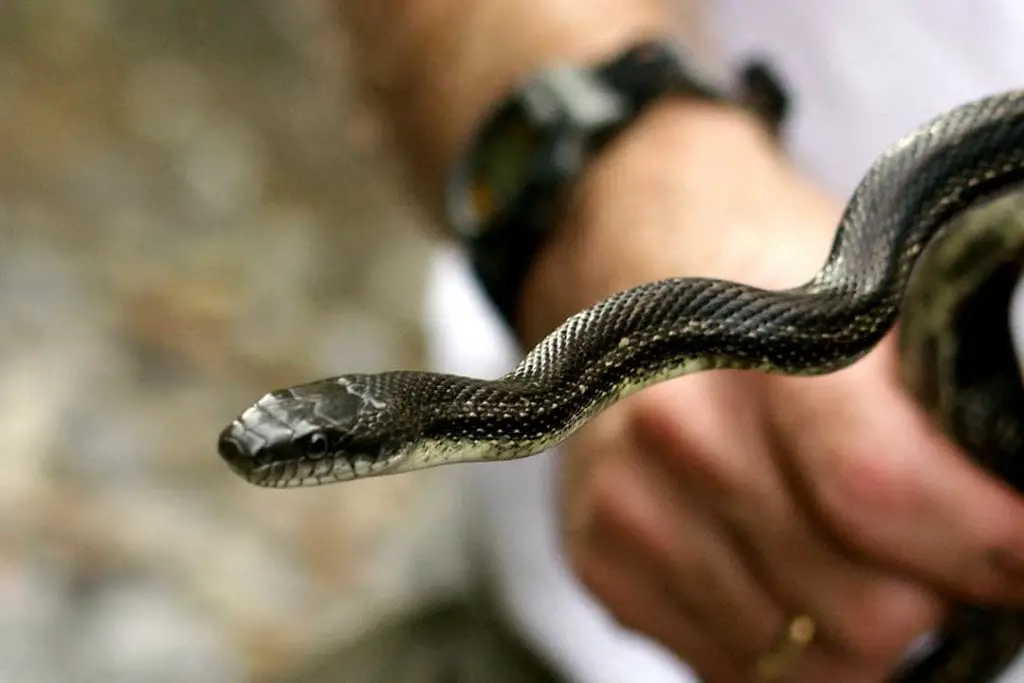
The gray rat snake is 42-72 inches long fully grown. Adults have a lighter gray tone as a background color with a darker gray series of blotches down the body.
They only live in the Panhandle east of the Apalachicola River. They eat a wide range of vertebrate prey. The gray rat snake will kill via constriction or may eat small prey alive.
These snakes frequently interbreed with Eastern ratsnakes in the wild.
Eastern, Yellow, or Everglades Ratsnake (Pantherophis alleghaniensis)
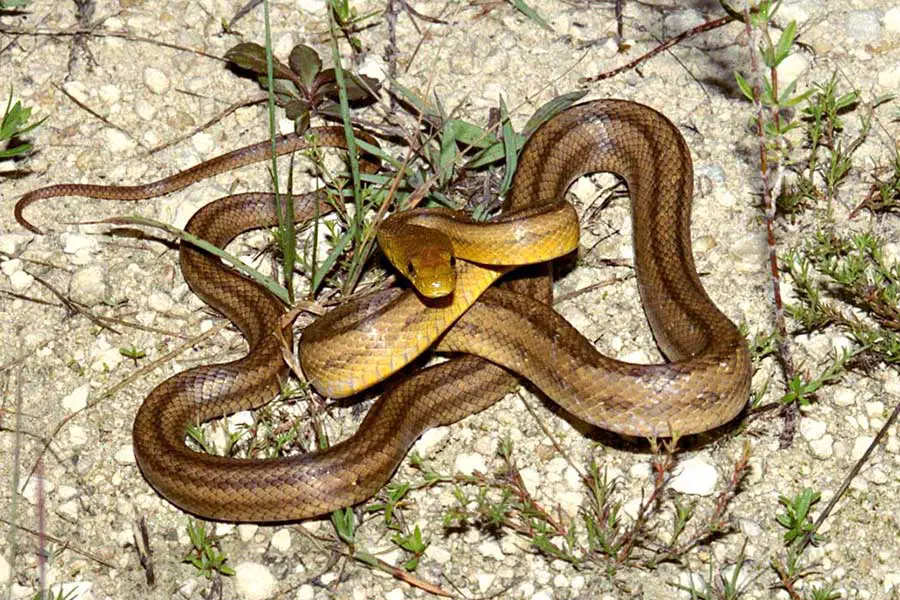
The Eastern ratsnake is highly variable in appearance depending on where you find them.
These snakes are between 42 and 72 inches as adults. All juveniles are gray with dark blotches. Snakes from the Panhandle look similar to juveniles.
Once you get to the peninsula, most animals will be orange, tan, or yellow with stripes that run down the body. Eastern ratsnakes can be found in the panhandle to the east of the Apalachicola River.
They live throughout the peninsula and can be found as far south as Key Largo. These snakes eat a wide range of prey. They are primarily constrictors, but they will eat prey alive if they can manage it.
Pine Woods Snakes (Rhadinea)
Pine Woods Littersnake or Yellow-Lipped Snake (Rhadinea flavilata)
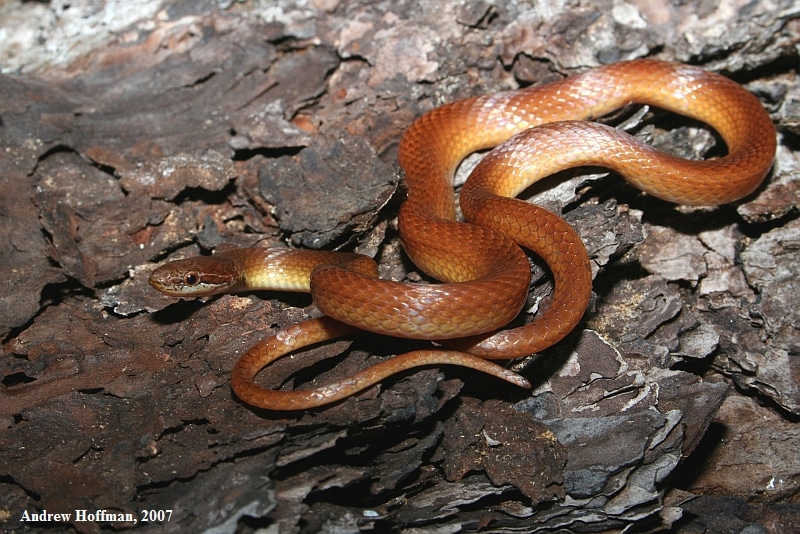
The pine woods littersnake is a slender snake that will be 10-13 inches long as an adult. They are reddish-brown to reddish-orange with whitish-yellow lips.
They can be found in most of the peninsula north of Lake Okeechobee but go further south to Broward County along the coast. They also live in the southern Panhandle to the west of Franklin County.
They are not found in the Keys. They eat small reptiles and amphibians. These snakes are rarely seen even in areas they are abundant.
Ring-Necked Snakes (Diadophis)
Ring-Necked Snake (Diadophis punctatus)
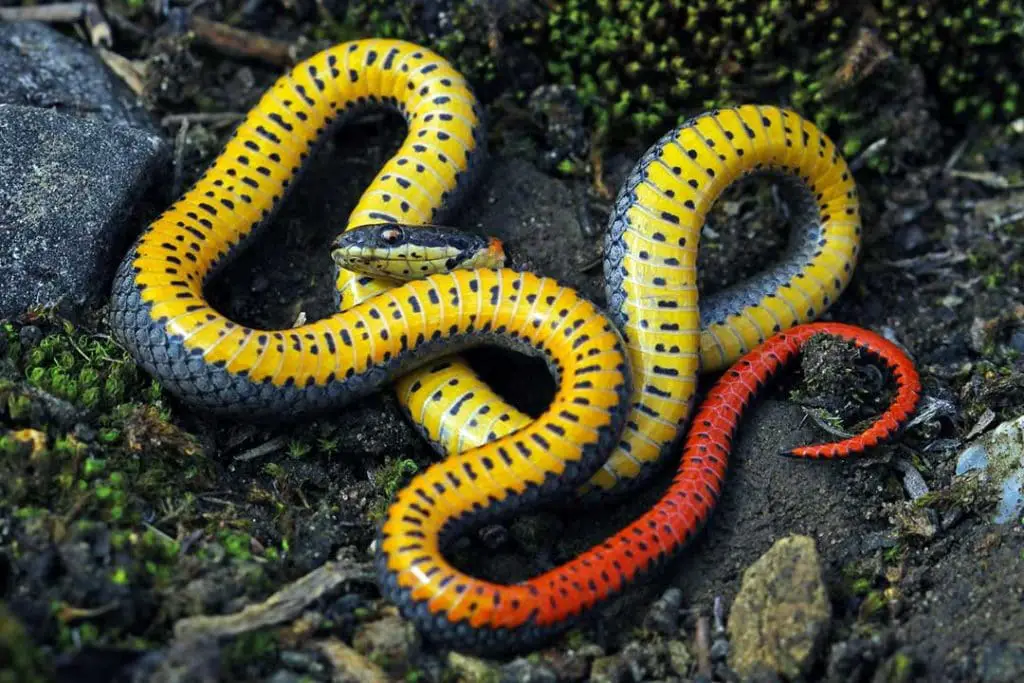
Ring-necked snakes are small snakes that tend to be 8-14 inches long. They have a dark body with a yellowish ring of scales around the neck.
Some animals may not have a complete ring or have it missing. The belly is bright yellow, orange, or red. You can find these snakes throughout the entirety of Florida.
Ring-necked snakes are nocturnal and eat small reptiles, invertebrates, and amphibians. These snakes will roll up their tails and display the bright colors on the underside as a threat display.
Scarlet Snakes (Cemophora)
Scarlet Snake (Cemophora coccinea)
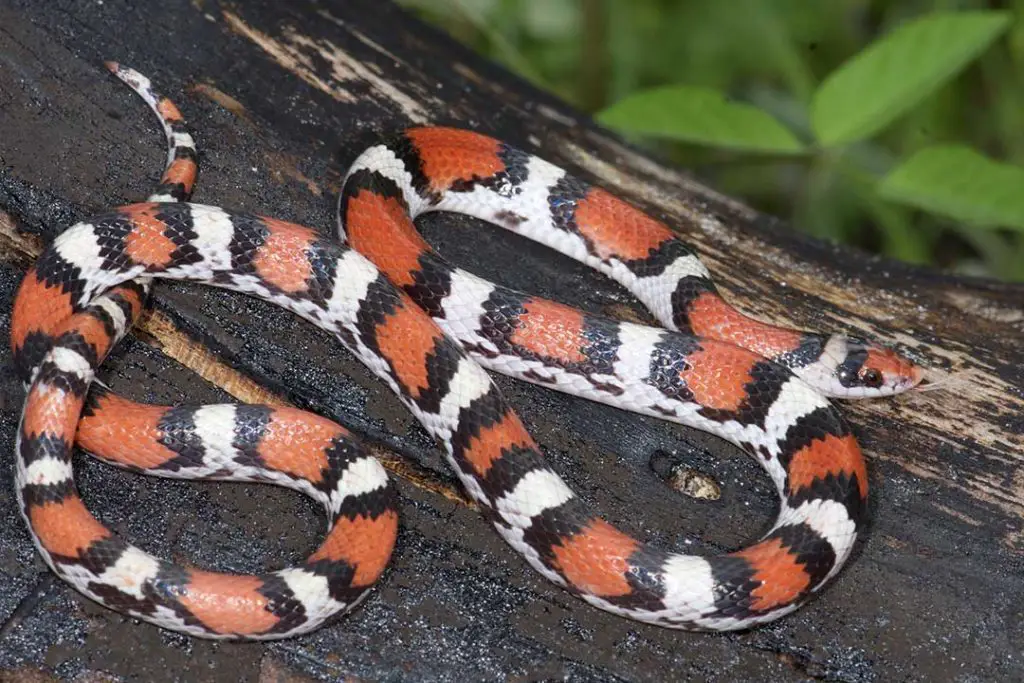
The scarlet snake is a small snake that is typically 14-20 inches long as an adult. They have red blotches down the back that are bordered with black on a light background.
They are commonly confused for the coral snake, but scarlet snakes have blotches rather than rings and a longer snout. Scarlet snakes are found in all of Florida aside from the Keys. The main part of the diet is reptile eggs.
Earthsnakes
Smooth Earthsnake (Virginia valeriae)
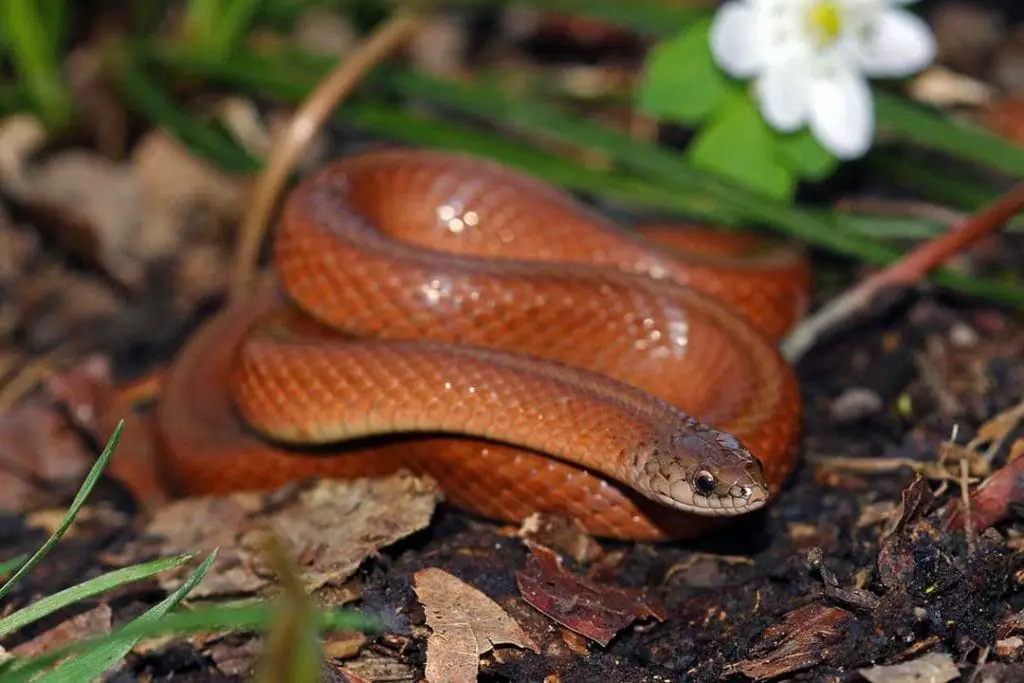
Smooth earthsnakes are 7-10 inches long. They are glossy brown or reddish-brown with dark flecks. Juveniles are darker. They are found in the Panhandle and have a small population in Highlands County along the Lake Wales Ridge.
They eat earthworms and other soft-bodied prey. These snakes were elevated to a species in 1991 and are rarely seen.
Rough Earthsnake (Haldea striatula)
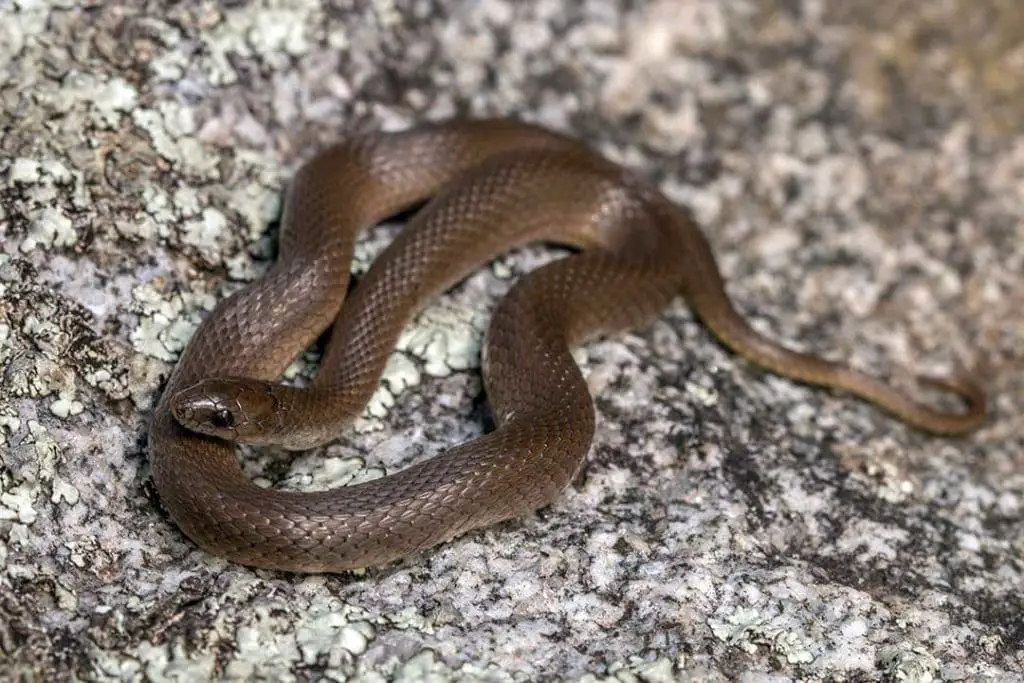
The rough earthsnake is 7-10 inches long. They are a glossy brown with a yellow or cream belly. They have a small head with a pointed snout and ridged scales.
Juveniles are typically darker and have a light ring around the neck. They live north of Alachua County in the peninsula and the western half of the Panhandle.
They eat earthworms and some insects and their larva. These snakes have been placed in several genera with the most recent shift placing them back in Haldeafrom the previous genus Virginia.
Pythons (Python)
Burmese Python (Python bivittatus)
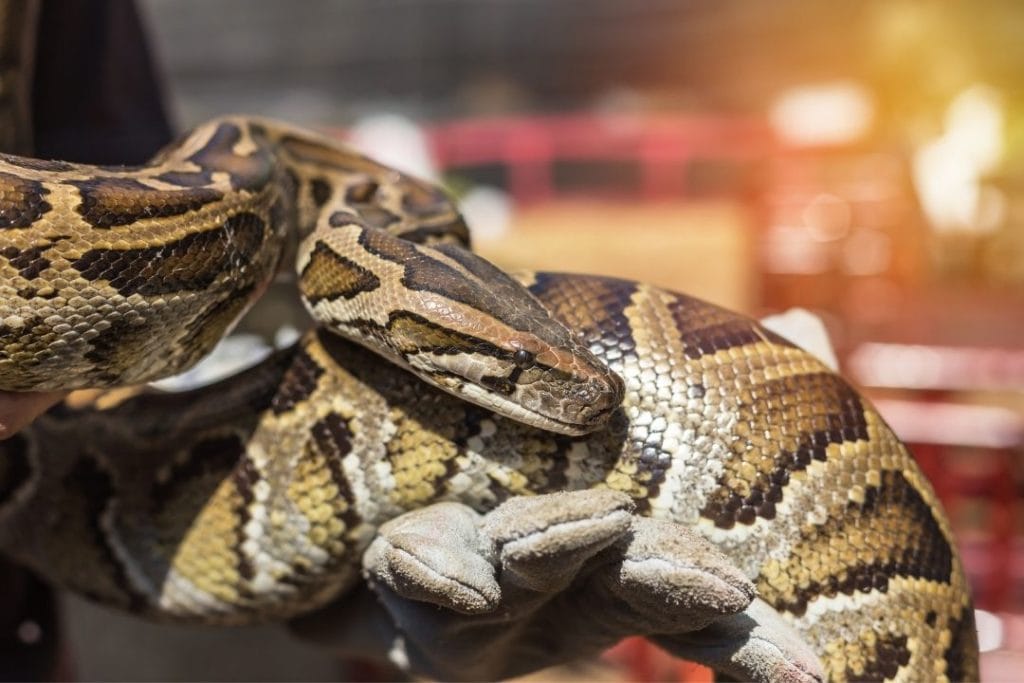
Burmese pythons are 10-16 feet long as adults.
They have a light background color with dark brown blotches bordered in black.
They are an invasive species that has been spotted in much of Florida, but most live in the Everglades and the southern peninsula.
This non native snake species can eat massive amounts of animals and they have virtually eliminated many small and medium mammals from the Everglades.
African Rock Python (Python sebae)
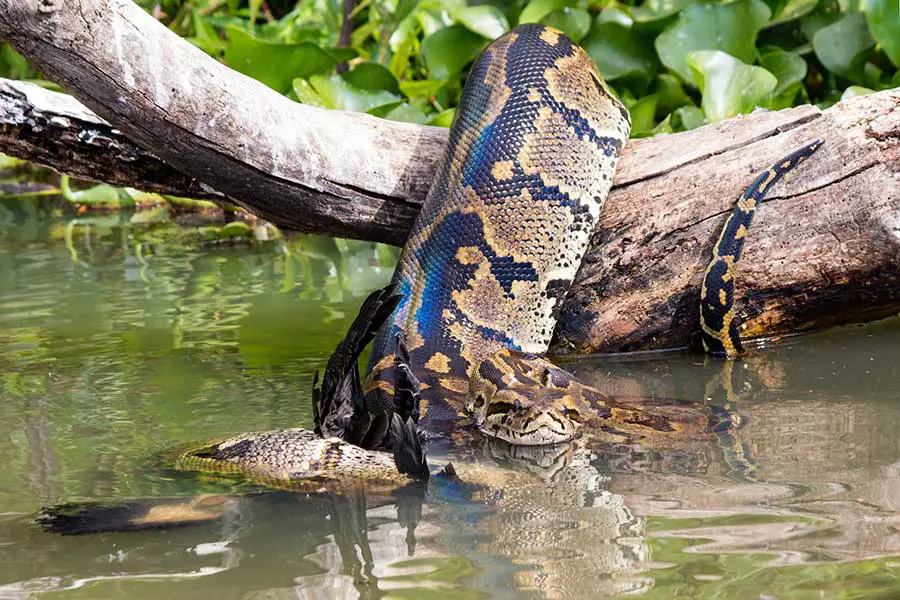
African rock pythons are 10-16 feet long as adults. They have a brownish background color with two mostly continuous, irregular dark blotches down the back.
The blotches are bordered by black and white. They are native to Africa and a small population has been established in Miami-Dade County near US 41 and SR 997.
These snakes eat many mammals and birds and are very strong.
Boas (Boa)
Common or Red-Tailed Boa (Boa constrictor)
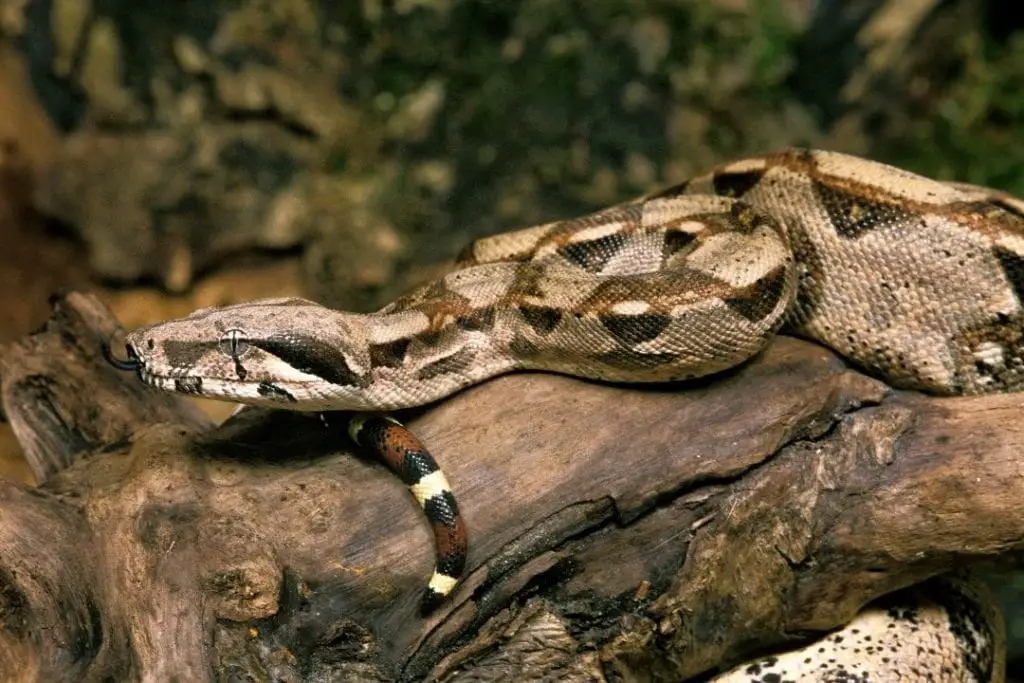
The common boa can reach 13 feet long, but most stay around 8 feet.
They have a light brown background color with dark hourglass-shaped saddles that turn to red bands at the tail.
They are currently only established on the Charles Deering Estate in Miami-Dade County and are not native to Florida.
Blindsnakes (Indotyphlops)
Brahminy Blindsnake (Indotyphlops braminus)
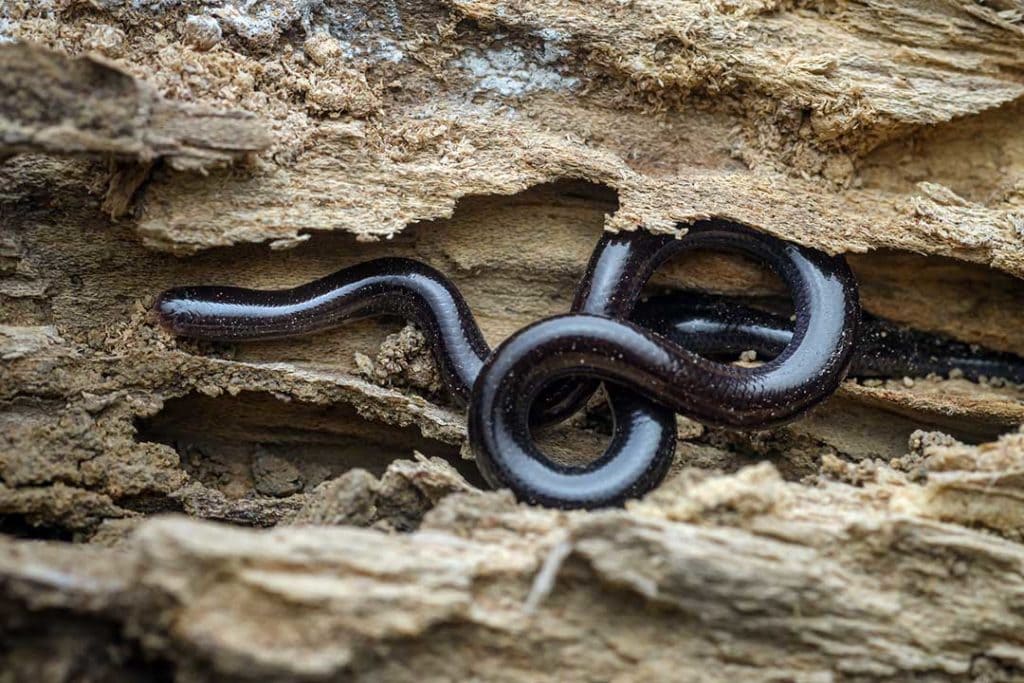
Brahminy blindsnakes are a non-native species. Blind snakes tend to be between 4.4 and 6.5 inches long. They have shiny scales that can be gray or purple.
The head and tail are stubby and hard to differentiate. These harmless snakes can be found from Key West to most of the peninsula with a few scattered reports from the Panhandle.
These snakes eat the eggs, larvae, and pupae of ants and termites. Brahminy blindsnakes are burrowing snakes that have completely lost their eyesight. They still have eyes, but they are under their scales on the head.
Venomous
7 native species are considered venomous. This means that their venom can cause harm to humans if they are bitten.
If you are bitten by a venomous snake, take a picture of the snake that bit you and seek medical attention immediately.
Most bites occur when someone is trying to kill or handle the snake.
Pit Vipers (Croatalinae)
Eastern Diamond-Backed Rattlesnake (Crotalus adamenteus)
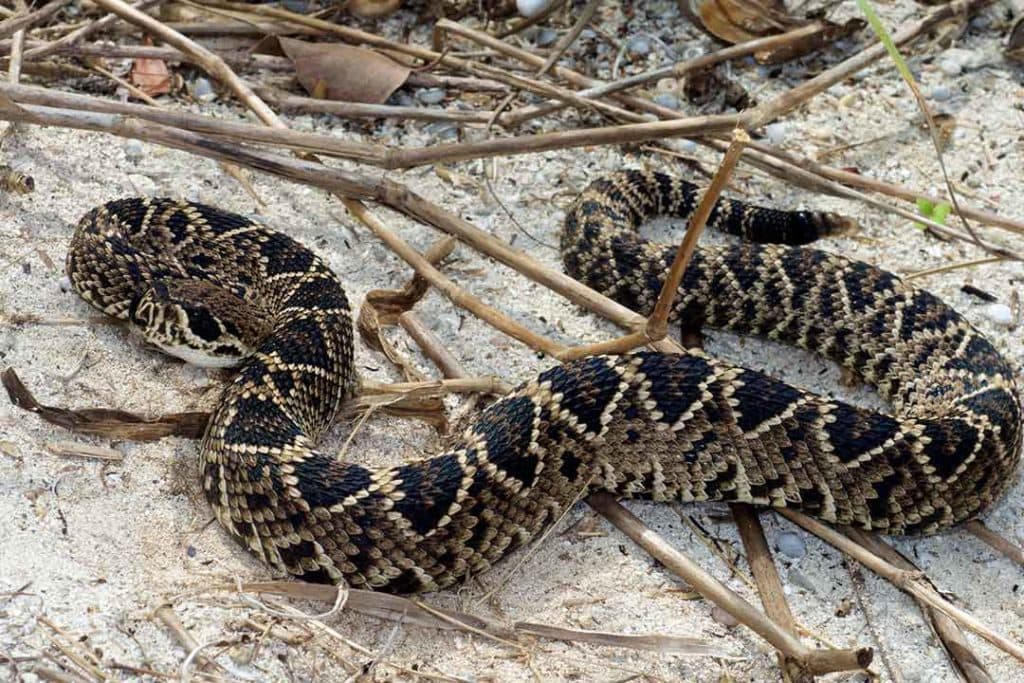
Eastern diamond-backed rattlesnakes are very large and heavy snakes that average 33-72 inches long. They are brownish with dark diamonds with brown centers and cream borders down the back.
Like other pit vipers, they have a heat pit under the eye. The head is distinct from the neck and thick and the eye has a vertical pupil.
The rattle on the tail is normally carried in the air. Juveniles look nearly identical, but they are born with only one rattle segment called a button.
These venomous species are found everywhere in Florida including most of the Keys and many barrier islands. they use their venom to hunt mainly mammals like rodents and rabbits, but they will also eat birds.
Pygmy Rattlesnake (Sistrurus miliarius)
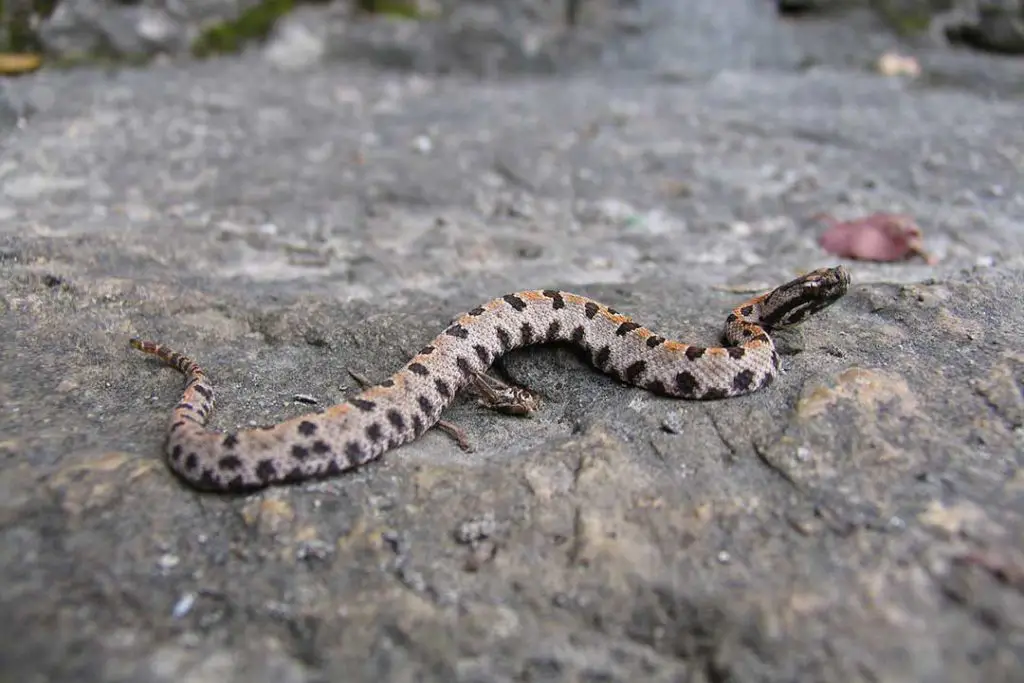
The pygmy rattlesnake are typically 12-24 inches, but have a thick body for their size.
They can be varying shades of gray as a background color and they have black or dark gray blotches down the back. In between the blotches is a red stripe down the back.
The head is thick with a distinct neck. Juveniles look nearly identical, but they have a bright yellow tail tip. They live everywhere in Florida aside from the Keys.
They can be confused for hognose snakes, but hognoses have an upturned nose scale and lack a rattle.
Timber Rattlesnake (Croatlus horridus)
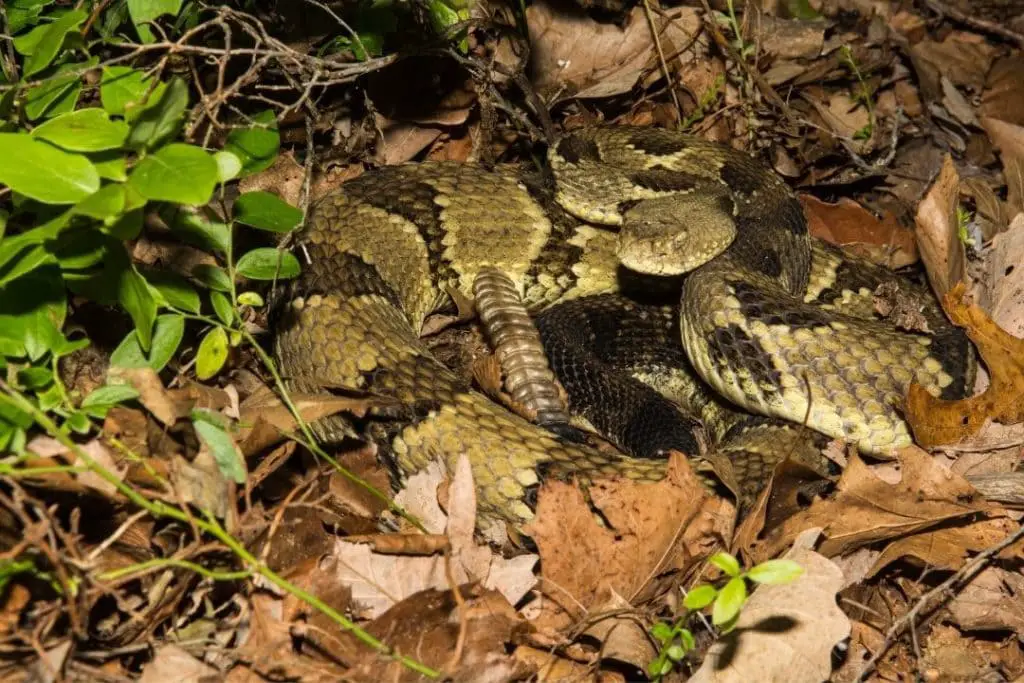
The timber rattlesnake is a thick-bodied snake that is 36-60 inches long. They have a pinkish or gray body with dark chevrons down the back.
The head is large and distinct from the neck.
They have a black tail tipped with a rattle. They are only found in 12 counties in northern Florida. These snakes are also called canebreak rattlesnakes.
Copperhead (Agkistrodon contortrix)
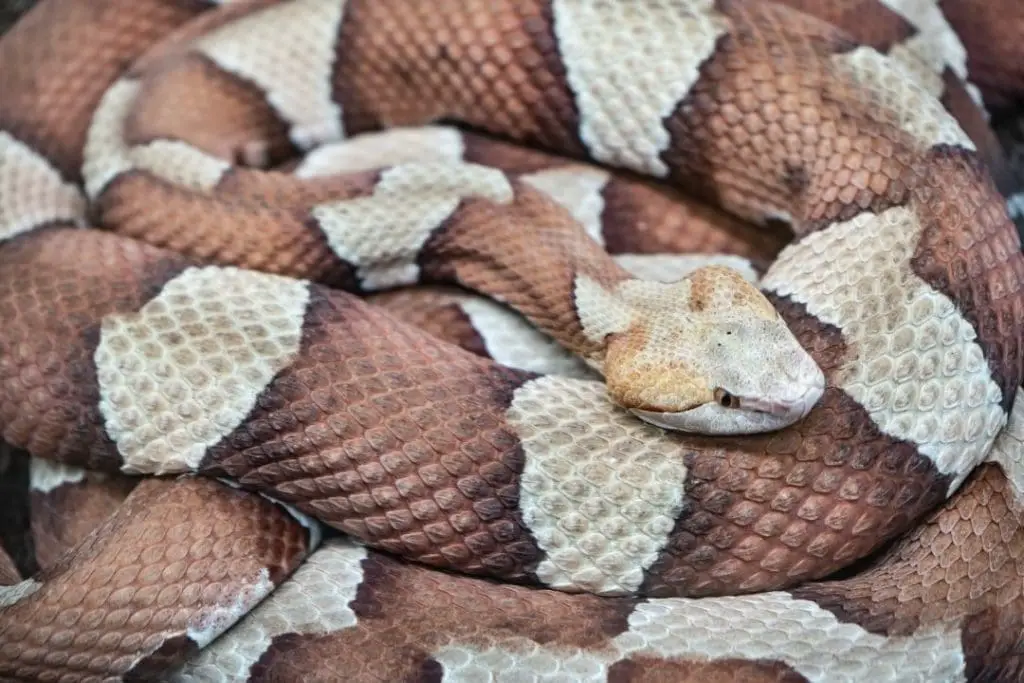
Copperheads are thick snakes that average 22-36 inches long. They have a distinctive hourglass-shaped pattern and are light brown with darker brown markings.
Babies are identical to adults aside from a bright yellow tail tip used to lure prey close. They have thick, triangular heads with a brow scale over the slit-pupiled eye.
The southern copperhead can only be found in the Panhandle area. Adults hunt primarily mammals and juveniles eat smaller prey.
Copperhead venom is painful and can be deadly for children and small animals. The copperhead is the deadliest snake in Florida.
Northern Cottonmouth (Agkistrodon piscivorus)
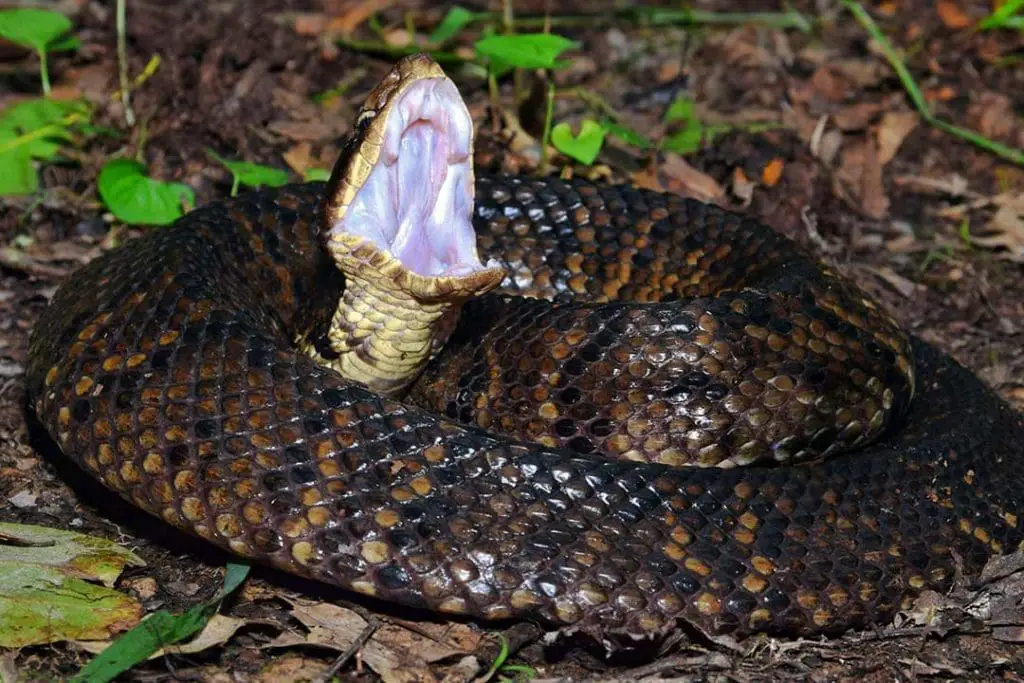
The Northern cottonmouth averages 31 inches long and males are larger than females. Adults are typically black aside from the facial markings on their thick and bulky heads.
Juveniles are lighter and have visible patterning with a bright tail tip. They are only found in the Panhandle, where they commonly breed with the lighter Florida cottonmouth.
They eat primarily fish and frogs but will eat nearly any prey including other cottonmouths.
Florida Cottonmouth (Agkistrodon conanti)
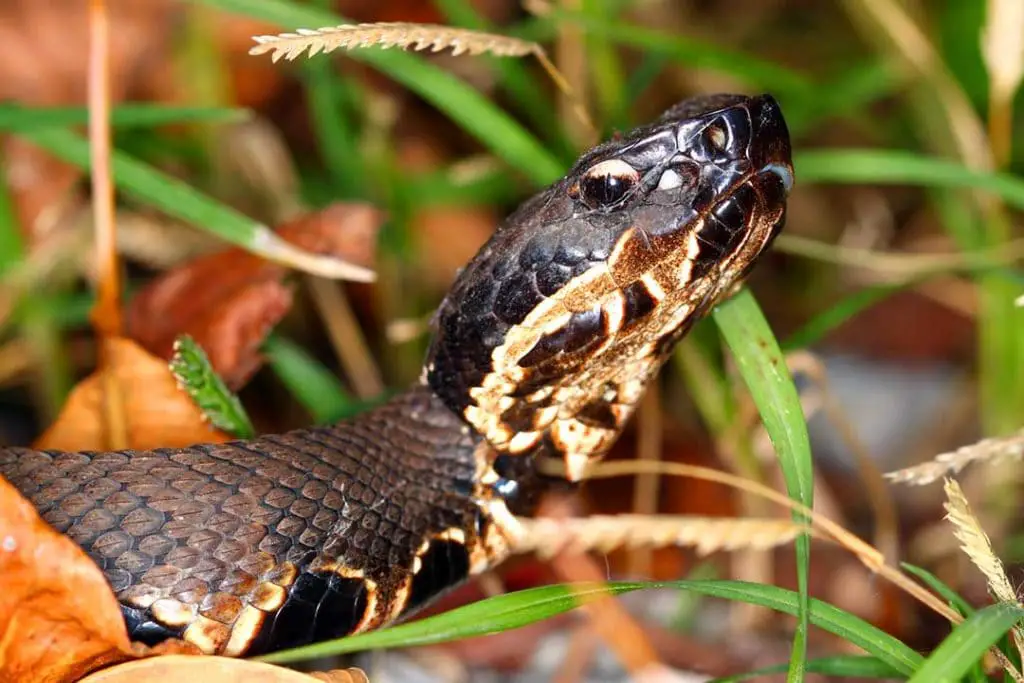
The Florida cottonmouth is one of two venomous semi-aquatic snakes found in Florida. They are heavy-bodied animals and tend to be 30-48 inches as adults.
They have light and dark brown bands. The head is thick with a distinct neck. Like other pit vipers, they have vertical pupils and a facial pit under the eye along with a brow scale.
Juveniles are lighter and they are born with a bright tail tip. These snakes are found in all of Florida including islands around the coast.
They tend to stick close to the water but have been found even in areas without any freshwater sources. These snakes are generalists and will eat anything they can find including other cottonmouths.
Elapids (Elapidae)
Coral Snake (Micrurus fluvius)
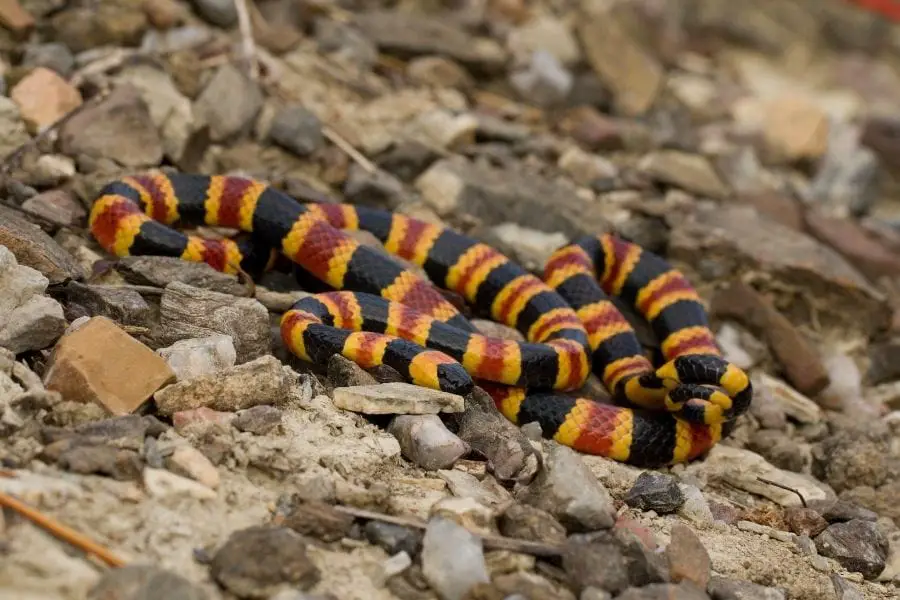
The coral snake is a slender snake that tends to be 20-30 inches long. They have a bright pattern of rings down the body. The red and black rings are larger and separated by thin rings of yellow.
The head is small and black with a short snout. Coral snakes will hide their head under the coils of the body and wave their tail in the air when they feel threatened.
Coral snakes are found in all of Florida and Key Largo.
They eat small lizards and snakes they find while foraging in leaf litter. They are rarely seen and rarely bite, but they do have a deadly venom and bites can be incredibly dangerous.
Frequently Asked Questions
Conclusion
There are many species of snake in Florida.
Due to the climate, many invasive species can become established wild animals. Learn about native species and report any sightings of non-native species to your local authorities.
If you have any questions or comments, please leave them below.
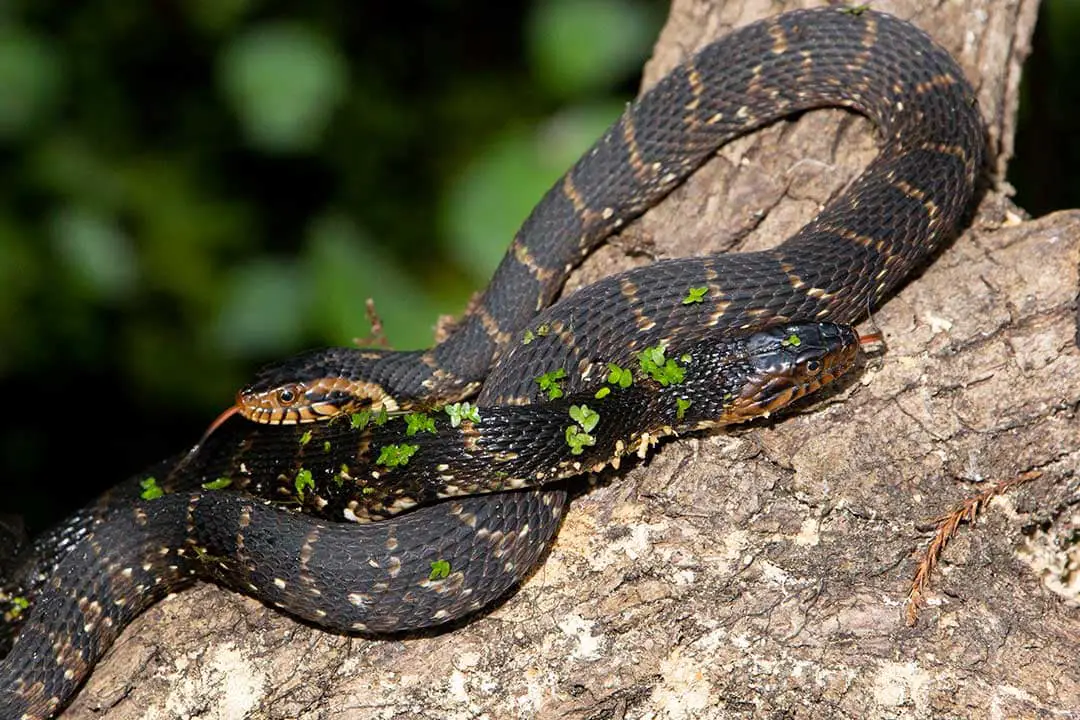
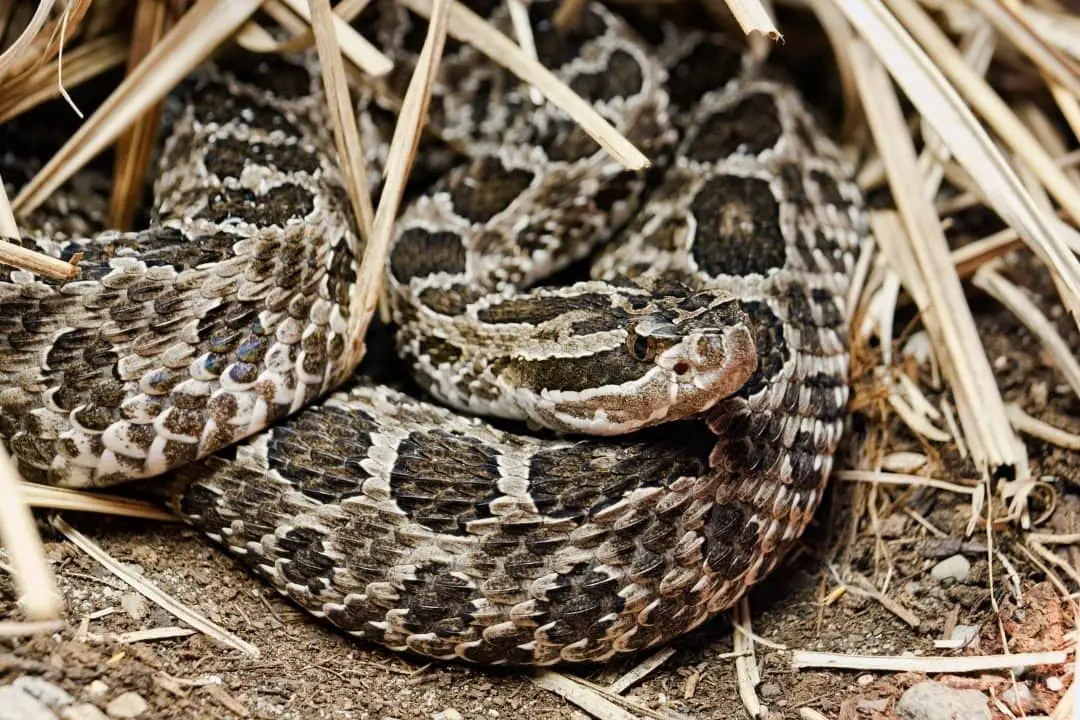
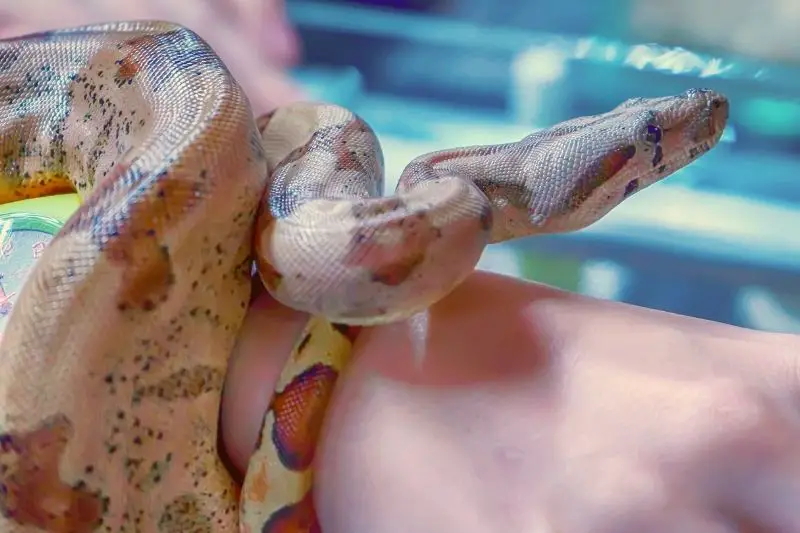
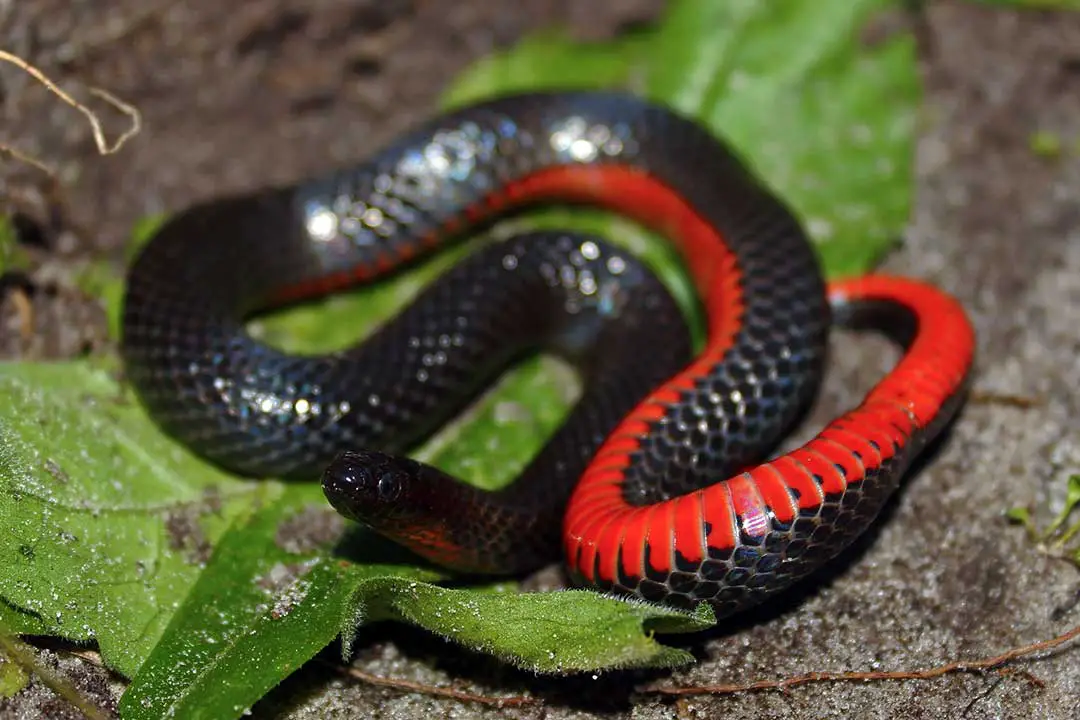

Very nice compilation of snakes for Florida and a nice read. My sister saw an all brown looking water snake and was wondering if we could send a photo to see if you could ID it or seen hybrids that look like that. Thanks